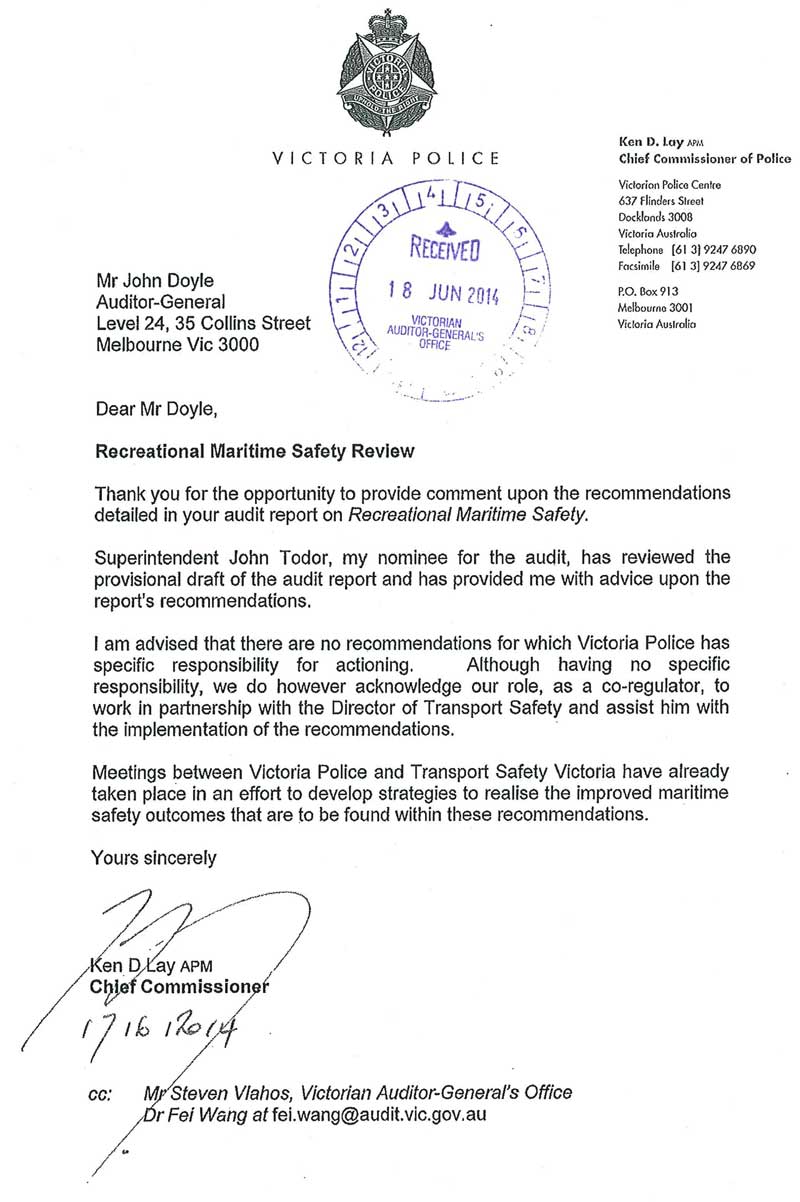Recreational Maritime Safety
Overview
Victoria’s recreational boating industry is important to our economy and to Victorians’ quality of life. In the past five years almost all maritime safety incidents on state waters have involved recreational vessels, and a new marine safety regulatory framework was introduced in 2012 to better manage safety risks.
The framework depends heavily on Transport Safety Victoria's (TSV) effective coordination with voluntary waterway managers and enforcement bodies to maximise duty holders' compliance with their safety obligations. However, TSV cannot demonstrate that it is effectively and efficiently regulating marine safety because it has no framework for reliably evaluating:
- the effectiveness of its regulatory approach, and whether duty holders, waterway managers and enforcement bodies are fulfilling their responsibilities to cost effectively minimise safety risks
- the competence and ongoing suitability of appointed waterway managers, and whether they are actively discharging their voluntary role
- if the state's longstanding waterway rules remain fit for purpose and effective, and support the efficient management of current safety risks
- whether critical information on system-wide marine safety risks and related enforcement strategies is adequately leveraged by TSV, waterway managers and Victoria Police to continuously improve their management of marine safety.
The absence of such arrangements reduces TSV's accountability for performance, and significantly impedes its ability to regulate effectively. Consequently, TSV cannot adequately assure Parliament, the Minister for Ports or the community that its current approach to regulating marine safety is working.
Ongoing concerns about the adequacy of funding to TSV and waterway managers means that the Department of Transport, Planning and Local Infrastructure—in consultation with the Director, Transport Safety, and central agencies—needs to urgently review and provide assurance about the adequacy of current resourcing arrangements for effective implementation of the marine safety regulatory framework.
Recreational Maritime Safety: Message
Ordered to be printed
VICTORIAN GOVERNMENT PRINTER June 2014
PP No 332, Session 2010–14
President
Legislative Council
Parliament House
Melbourne
Speaker
Legislative Assembly
Parliament House
Melbourne
Dear Presiding Officers
Under the provisions of section 16AB of the Audit Act 1994, I transmit my report on the audit Recreational Maritime Safety.
The audit assessed the effectiveness and efficiency of the state's marine safety regulatory framework in minimising safety risks for recreational maritime uses. It examined the Director, Transport Safety, supported by Transport Safety Victoria (TSV), in his role as the state's regulator of recreational maritime safety and as a waterway manager. It also examined five other waterway managers, the related enforcement activities of Victoria Police, and the Department of Transport, Planning and Local Infrastructure's (DTPLI) role in coordinating regulatory policy and legislation advice relating to marine safety.
I found that the state's regulatory framework is not being effectively or efficiently implemented. A key shortcoming is the absence of arrangements within TSV for reliably assuring the effectiveness of its regulatory approach, the competence and ongoing suitability of waterway managers, and that longstanding waterway rules remain fit for purpose and support the efficient management of safety risks.
I have made a series of recommendations aimed at improving the effectiveness and efficiency of the marine safety regulatory framework. I am encouraged by the Director, Transport Safety's and DTPLI's commitment to implementing actions against these recommendations.
Yours faithfully

John Doyle
Auditor-General
25 June 2014
Auditor-General's comments
Auditor-General's comments
 John Doyle Auditor-General |
Audit team Steven Vlahos—Sector Director Dr Fei Wang—Team Leader Ray Seidel-Davies—Senior Analyst Michele Lonsdale—Engagement Quality Control Reviewer |
Victoria has approximately 1 200 kilometres of ocean coastline and more than 3 000 square kilometres of inland and enclosed waters. These waters provide Victorians with valuable recreational opportunities that contribute greatly to our quality of life.
In 2012, a new marine safety regulatory framework was introduced to improve the management of safety risks arising from these activities, and from the significant growth in recreational boating, commercial shipping, and newly exposed hazards in inland waterways.
Under this framework, responsibility for managing marine safety is shared between the state's transport safety regulator—the Director, Transport Safety (the Safety Director)—designated waterway managers, and a range of other parties collectively known as 'duty holders' on whom the Marine Safety Act 2010 imposes an obligation to manage the safety risks arising from their activities.
My audit has found that the state's regulatory framework is not being effectively or efficiently implemented. Particularly concerning is that despite the framework's intent to improve the management of marine safety risks, its current implementation is dysfunctional.
Specifically, the regulatory framework depends heavily on the Safety Director's effective coordination with waterway managers and enforcement bodies. However, this is not currently being achieved. None of the examined waterway managers had established arrangements to systematically identify and, where relevant, manage safety risks on all waters under their control. Additionally, most waterway managers had not exercised their option to enforce marine safety laws because of their limited resources. Further, the Safety Director has no arrangements to systematically engage with waterway managers to share risk information and coordinate their enforcement strategies with his own and those of Victoria Police.
I also found that the Safety Director cannot demonstrate that he is effectively and efficiently regulating marine safety as he has no framework for assessing the impact of his regulatory approach, including performance of related parties in minimising safety risks.
These shortcomings are significant as they reduce the Safety Director's accountability for performance and impede his capacity to effectively regulate the marine safety system. They also highlight a need for my office to further examine the Safety Director's wider duties of regulating rail and bus safety when determining my future audit priorities.
I have made a number of recommendations for addressing these issues, which pleasingly the Safety Director and examined agencies have accepted. In particular, the recommendations reinforce the need for the:
- Safety Director to regularly assess and report on the performance of Victoria's marine safety system, and to use this information for targeting his regulatory activities
- Department of Transport, Planning and Local Infrastructure, in consultation with the Safety Director and central agencies, to urgently review the adequacy of current resourcing arrangements for supporting effective implementation of the regulatory framework.
I would like to thank the staff of Transport Safety Victoria, the Department of Transport, Planning and Local Infrastructure, the Department of Environment and Primary Industries, Parks Victoria, Goulburn Murray Rural Water Corporation, Gippsland Ports Committee of Management, Gannawarra Shire Council and Victoria Police for their assistance and cooperation during this audit.
I look forward to receiving updates from them in implementing the recommendations.

John Doyle
Auditor-General
June 2014
Audit Summary
Audit summary

The marine industry is vital to Victoria's economy, contributing around $4.5 billion per year and employing over 7 000 people in manufacturing, wholesaling and retailing. Water-based recreational activities also contribute greatly to Victorians' quality of life.
However, the growing popularity of these activities, coupled with the significant scale and, in some cases, remoteness of state waters highlights both the challenge and need for the state to effectively manage the associated safety risks.
Over the five years to 2012–13, almost all maritime safety incidents on state waters have involved recreational vessels only—approximately 97 per cent. While the numbers of fatalities and serious injuries have been relatively stable over this period—averaging around five and 24 per year respectively—the aggregate number of recreational marine incidents increased from 1 084 to 1 341, or by 24 per cent.
The Marine Safety Act 2010 (the Act) and the Marine Safety Regulations 2012 (the Regulations) provide for safe marine operations in Victoria by prescribing requirements for vessel registration, operation, safety equipment, licensing of operators and enforcement of safety standards.
The Act and the Regulations came into operation on 1 July 2012, replacing the former Marine Act 1988 and Marine Regulations 2009, with the aim of improving the management of marine safety risks.
The Director, Transport Safety (the Safety Director), supported by Transport Safety Victoria (TSV), is the state's regulator of transport safety. The Act establishes that the responsibility for managing marine safety is shared between the Safety Director, designated waterway managers and a range of other parties collectively known as 'duty holders' on whom the Act imposes an obligation to manage the safety risks arising from their activities. Key duty holders include port management bodies and members of the public who participate in maritime activities, as well as the suppliers and operators of vessels and equipment used for such activities.
The audit assessed the effectiveness and efficiency of the state's marine safety regulatory framework in minimising safety risks for recreational maritime uses. The audit examined TSV in its role as the state's regulator of recreational maritime safety and as a waterway manager, as well as five additional waterway managers including the Department of Environment and Primary Industries (DEPI), Parks Victoria, Goulburn‑Murray Rural Water Corporation, Gippsland Ports Committee of Management and Gannawarra Shire Council.
The audit also examined the related enforcement activities of Victoria Police, and the Department of Transport, Planning and Local Infrastructure's (DTPLI) role in advising on regulatory policy and legislation relating to maritime safety.
Conclusions
The state's regulatory framework for minimising marine safety risks is not being effectively or efficiently implemented.
The framework depends heavily on TSV's effective coordination with voluntary waterway managers and enforcement bodies to maximise duty holders' compliance with their safety obligations. However, it is not evident that this is being achieved as TSV cannot demonstrate that it is effectively and efficiently regulating marine safety. This is because it has no framework for reliably evaluating:
- the effectiveness of its regulatory approach, and whether duty holders, waterway managers and enforcement bodies are fulfilling their responsibilities to cost‑effectively minimise safety risks
- the competence and ongoing suitability of appointed waterway managers, and whether they are actively discharging their voluntary role
- if the state's longstanding waterway rules remain fit for purpose, effective, and support the efficient management of current safety risks
- whether critical information on system-wide marine safety risks and related enforcement strategies is adequately leveraged by TSV, waterway managers and Victoria Police to continuously improve their management of marine safety.
The absence of such arrangements reduces TSV's accountability for performance, and significantly impedes its ability to effectively regulate. Consequently, TSV cannot adequately assure Parliament, the Minister for Ports or the community that its current approach to regulating marine safety is working.
Ongoing concerns about the adequacy of funding to TSV and waterway managers means that DTPLI, in consultation with the Safety Director and central agencies, needs to urgently review and assure the adequacy of current resourcing arrangements for supporting effective implementation of the marine safety regulatory framework.
Findings
Monitoring the marine safety system
System-wide monitoring arrangements
A key object of the Act is to promote the effective management of safety risks. The Safety Director, supported by TSV, has a range of statutory functions that create a strong imperative for monitoring the performance of the marine safety system in achieving this object. These include:
- monitoring compliance with marine safety laws
- making appropriate waterway rules
- developing and enforcing appropriate standards for navigation, maritime safety and related infrastructure
- coordinating and supporting the effective implementation of enforcement by members of the police force, transport safety officers and waterway managers.
While the Safety Director has no explicit function under the Act to oversee waterway managers, the state's 2009 review of the former Marine Act 1988 recognised that the above functions nevertheless require the Safety Director to exercise a level of oversight. However, TSV's existing monitoring arrangements do not enable the Safety Director to assess whether all of these functions are being effectively carried out.
TSV has procedures in place for auditing waterway managers and reporting on marine incidents, but there are no defined performance targets or documented arrangements for monitoring, assessing and reporting on the effectiveness of the wider marine safety system.
This information is needed urgently to enable TSV to focus and prioritise its regulatory activities, as this audit has identified critical shortcomings in risk management, safety controls and agency coordination in promoting and enforcing compliance with marine safety laws.
In October 2013, TSV started work to establish a more comprehensive framework to benchmark its regulatory performance through measuring the costs and benefits of its regulatory work, along with its efficiency and effectiveness. However, it has not set a time frame to complete this work.
Funding arrangements for marine safety management
TSV and waterway managers have consistently identified the lack of funding as a critical issue that impedes their ability to effectively regulate marine safety. TSV has also indicated that, based on its experience, the capacity and willingness of waterway managers to discharge their statutory functions is directly proportional to their allocated funding, which in most cases is minimal.
Notwithstanding this, shortcomings in TSV's performance monitoring mean that it cannot demonstrate that its existing regulatory resources are being effectively applied.
The funding for recreational maritime safety is derived from state appropriations that can include fees charged for licensing recreational operators and the registration of their vessels. The Act, consistent with the former Marine Act 1988, establishes that all prescribed revenue from these fees must be used for boating and related safety programs.
The revenue collected from these fees forms part of the state's consolidated revenue administered by the Department of Treasury and Finance and is allocated through the annual Budget process.
Although the Regulations prescribe only registration revenue for these purposes, the DTPLI advised that the manner in which it has previously recorded the use of these revenues has encouraged a misconception that licensing revenue must also be used for boating facilities and related safety programs.
Consequently, we found that DTPLI records do not provide sufficient information to reliably acquit the use of registration fee revenues.
DTPLI records indicate that approximately $103 million of the $201 million in licensing and registration fee revenue collected from the sector between 2001–02 and 2012–13 was from registration fees, and that total allocations to enforcement activities and from the Boating Safety Facilities Program (BSFP), during this period amounted to $10.8 million and $56.5 million respectively.
However, DTPLI advised that it cannot confirm the difference between fee revenues collected from and expended in the sector. This is because its records are based on an assumed, notional allocation of these fees to its related programs, given that they are not separately identified in annual appropriations received through the Budget process.
Notwithstanding this, DTPLI advised that the state's expenditure in the marine sector over this period has exceeded fee revenues collected when annual expenditure via the BSFP and its Local Ports Program is considered. While it is evident that this expenditure has occurred and exceeds annual revenues from registration fees, DTPLI acknowledges that it cannot formally acquit that all registration revenue has been fully expended in accordance with the Act.
A February 2011 briefing from the former Department of Transport to the then Minister for Ports advised of a discrepancy between revenue collected and revenue allocated to the marine sector from the Consolidated Fund.
The then Minister for Ports wrote to the then Treasurer highlighting the funding challenges faced by local ports. He also signalled his intention to seek government approval to allocate all boating registration and licensing fee revenues from 2011–12 to the BSFP and Local Ports Program, which both support recreational boating.
DTPLI advised that this proposal was not supported, and it therefore did not proceed for consideration by government.
This situation, coupled with the deficiencies in statewide risk management and performance monitoring, means that there is insufficient assurance that available fee revenue is being effectively and efficiently applied across the marine safety system to manage risks.
Identifying and managing safety risks
Transport Safety Victoria's oversight of statewide risks
As the state's transport safety regulator, the Safety Director needs to assure the effective management of safety risks on all state waters, including those without a designated manager. TSV's legal advice is that the Act does not explicitly mandate this or require the Safety Director to become the 'default' waterway manager in such circumstances. Nevertheless, in a purely operational sense the Safety Director needs to understand the nature of prevailing safety risks across the state's waterways in order to assess the level and nature of his shared responsibility under the Act to control, eliminate or mitigate them.
Although TSV has developed a conceptually sound risk assessment tool, its implementation is compromised by key information gaps and an over-reliance on the deficient risk management practices of most waterway managers. Administering the tool is also resource intensive as it requires TSV to manually compile and maintain a large volume of data for all of the state's 184 managed waterways.
A key shortcoming is that the tool does not adequately consider the risks across the state's unmanaged waterways. These shortcomings mean TSV cannot be confident it accurately understands the nature or severity of all marine safety risks across the state. TSV advised it intends to address this issue.
Waterway managers' oversight of local risks
Waterway managers also need to accurately understand the nature and severity of prevailing safety risks on waters under their control so as to assess their consequential impact, if any, on their shared responsibility to manage them.
However, none of the waterway managers we examined had established arrangements to systematically identify, assess and monitor all safety risks on all waters under their control. Consequently, none could fully demonstrate that all of their safety controls and recreational waterway users comply with the Act and the Regulations and that safety risks are being effectively managed.
Parks Victoria and the Gippsland Ports Committee of Management had identified and assessed the safety risks for local ports they manage under the Port Management Act 1995 and events on high-risk waterways managed under the Act. However, it was not evident that they had done the same for all of the other non-port-related waterways in their control under the Act, which they advised was due to there being no designated funding.
TSV's audits of 82 waterways over a three-year period to 2013 found 85 per cent of navigational aids and signage at these waterways did not comply with applicable requirements—for example, buoys and safety signage were in the wrong location, signage was incorrect or missing. TSV highlighted that this was in part because waterway managers did not have sufficient resources or the required capabilities to effectively discharge these functions.
Setting and maintaining waterway rules
Under the Act, the Safety Director has the power to make waterway rules that regulate or prohibit the operation of any vessel, or use of state waters by any person. These rules form a vital part of the control framework for managing recreational maritime safety risks and typically prescribe a range of matters, such as speed limits and areas where vessels and recreational users are prohibited.
Most of the state's existing waterway rules were set under the former Marine Act 1988. Since that time it is possible that many waterways, particularly inland rivers and lakes, have changed substantially in their usage and associated risk profile due to such circumstances as flooding, drought and population change. However, it is not evident that either TSV or waterway managers systematically review the appropriateness of waterway rules.
Consequently, there is little assurance that all existing rules adequately address current safety risks.
Promoting and enforcing compliance with regulatory requirements
Promoting voluntary compliance
TSV has targeted its education and communication activities based on known safety risks but has not yet rigorously evaluated their impact on improving recreational users' behaviour and compliance. Encouragingly, some of the waterway managers examined and Victoria Police have also undertaken education activities, but the impact of these has similarly not yet been assessed.
Consequently, there is little evidence that TSV, waterway managers and Victoria Police are working effectively as part of an integrated system of co‑regulators to promote compliance with safety obligations and minimise related risks.
TSV advised that it acknowledges the importance of evaluation but that it is highly dependent on limited and contestable grants from DTPLI's BSFP for education activities, which limits its capacity to undertake evaluations.
Enforcing compliance
The Act required TSV to develop a Marine Enforcement Policy within 12 months of the Act becoming operational and to consult with relevant stakeholders, including those parties involved in jointly enforcing compliance. Whilst TSV undertook limited consultation with Victoria Police, the Boating Industry Association of Victoria and Parks Victoria, it did not actively consult with the majority of other waterway managers. This shortcoming means TSV cannot be confident that all waterway managers adequately understand their related roles, including how they can use enforcement options to support their role in regulating boating activities and events on their waterways.
While past TSV enforcement activities have been risk-based, targeted and coordinated with those of Victoria Police, there are critical weaknesses that undermine its general approach. These include:
- concerns with the quality and reliability of data underpinning risk assessments
- no arrangements for assuring effective cross-agency coordination
- enforcement outside of high-use locations is limited
- no assessments of the efficiency and effectiveness of enforcement activities.
These weaknesses mean that TSV cannot demonstrate or be confident that current approaches to enforcement by responsible agencies are adequately coordinated, efficient and effective in achieving compliance with marine safety laws.
Weaknesses with TSV's cross-agency coordination mean that Victoria Police's current risk assessments are not informed by systematic input from all waterway managers and TSV on the status of current and emerging safety risks across all managed waterways. Victoria Police acknowledges that enhanced access to and coordination of risk information from waterway managers could assist its targeting of related enforcement activities.
Most waterway managers do not exercise their option to enforce marine safety laws because of their limited resources. However, TSV does not assess whether or not this lack of enforcement is compromising the effective discharge of waterway manager functions, including management of safety risks.
Assessing waterway managers' compliance
TSV's audits of waterway managers do not extend to systematically assessing the effectiveness of their risk management practices. Instead, such assessments are typically gleaned through ad hoc interactions with waterway managers or following safety incidents. Consequently, TSV's audits do not provide adequate insights into the effectiveness of waterway managers.
Supporting waterway managers
Assessing the capabilities of waterway managers
TSV has not determined the key capabilities required by waterway managers to carry out their legislative responsibilities, nor formally assessed the skills and knowledge of current waterway managers against those capabilities. Similarly, no assessment has been made of the ongoing suitability of previously appointed waterway managers, even though the majority of them have been in the role since 1988.
TSV's legal advice states that the Act does not prescribe explicit capability criteria for waterway managers. This, however, does not preclude TSV, in consultation with DTPLI, from developing a capability framework to inform current support to waterway managers, and any related recommendations to the Minister for Ports.
Changes in local conditions since 1988 mean that the synergies that existed previously with respect to the core responsibilities of some waterway managers may no longer exist.
TSV advised that due to the Safety Director's independence, its role in informing the decisions of the Minister for Ports on the appointment and/or reappointment of waterway managers is not clearly defined. Notwithstanding this, the Transport Integration Act 2010 empowers the Safety Director to make recommendations to the minister on the operation, administration and enforcement of the Marine Safety Act 2010 and associated Regulations. Better knowledge of waterway manager capabilities could therefore inform any related recommendations from the Safety Director to the minister. It would also aid TSV's targeting of its current support activities to waterway managers. The current lack of periodic reviews of waterway managers' capabilities means that TSV has limited insight into the nature or extent of any capability gaps among current managers or whether they should be continuing to perform that role.
We found that five waterway managers who had either resigned or intended to resign had done so in part because they did not perceive that the role aligned with their organisation's core functions.
DEPI similarly advised at the commencement of this audit that it no longer acknowledged or discharged its waterway manager functions—even though it is the declared manager for 36 of the state's waterways—because it no longer considered that it was the most suitable body to perform the role. Consequently, we found that DEPI has generally not responded to TSV's correspondence on the results of 11 audits it undertook of DEPI's waterways between 2008 and 2011. TSV advised that it was aware of DEPI's view and that it has worked to support it to continue in the role.
TSV also advised that, given its current resource constraints, it believes it is better to have a waterway managed by a local waterway manager even if they are only capable of undertaking a subset of the waterway manager functions.
These circumstances highlight a need for TSV to adopt a more proactive approach to systematically assuring and advising the Minister for Ports on the suitability and competence of declared waterway managers.
Providing guidance and training
TSV's guidance and training to waterway managers has been developed largely in response to their requests. However, TSV has not complemented this reactive approach with more targeted training based on a holistic assessment of waterway managers' capability gaps and needs. Therefore, TSV cannot be certain that it is making best use of its limited resources to effectively prioritise the content and timing of its support to waterway managers.
Recommendations
That the Director, Transport Safety:
- develops arrangements to systematically assess and report on the efficiency and effectiveness of Victoria's marine safety system, and related performance of duty holders and co-regulators, and uses this data to target regulatory activities
- reviews management of budgets and financial resources to assure existing funds are effectively and efficiently utilised to optimise regulatory outcomes.
That the Department of Transport, Planning and Local Infrastructure:
- consults with central agencies and the Director, Transport Safety, to review the adequacy of current resourcing arrangements for supporting effective implementation of the marine safety regulatory framework
- investigates options for the effective and efficient use of all existing revenues from the marine sector to improve marine safety management
- reports publicly on the collection and use of revenue from prescribed fees and all other funds it administers for boating safety and facilities to acquit the requirements of the Marine Safety Act 2010.
That waterway managers, in consultation with the Director, Transport Safety:
- establish effective arrangements to systematically identify, assess and monitor safety risks on waters designated to them for control under the Marine Safety Act 2010.
That the Director, Transport Safety:
- strengthens Transport Safety Victoria's waterway risk assessment practices by establishing arrangements to systematically:
- assure the quality and reliability of information it relies on from waterway managers to assess marine safety risks
- work with waterway managers to review and estimate the number of unmanaged waterways
- assess risks cost-effectively across the state's unmanaged waterways
- review and assure the appropriateness of existing waterway rules for managing current safety risks.
- periodically assesses the impact of Transport Safety Victoria's communication and education activities on achieving compliance with marine safety laws
- periodically assesses the effectiveness of Transport Safety Victoria's and co-regulators' enforcement activities—including the impact of the discretionary involvement of waterway managers in enforcement—on achieving desired regulatory outcomes.
That the Director, Transport Safety:
- broadens Transport Safety Victoria's audits of waterway managers to assure they provide adequate insights into the effectiveness of their risk management practices
- periodically follows up on Transport Safety Victoria's audits of waterway managers to assure that required remedial actions to improve marine safety have been satisfactorily addressed.
That the Director, Transport Safety, in consultation with the Department of Transport, Planning and Local Infrastructure:
- defines the minimum competencies and capabilities of waterway managers
- implements a waterway manager capability framework that includes periodic assessments of capability gaps to better inform provision of support to waterway managers
- uses the insights from these assessments to provide advice to the Minister for Ports on the appointment and/or reappointment of waterway managers.
Submissions and comments received
In addition to progressive engagement during the course of the audit, in accordance with section 16(3) of the Audit Act 1994 a copy of this report, or relevant extracts from the report, was provided to Transport Safety Victoria, the Department of Transport, Planning and Local Infrastructure, the Department of Environment and Primary Industries, Parks Victoria, Gippsland Ports, Goulburn‑Murray Rural Water Corporation, Gannawarra Shire Council and Victoria Police with a request for submissions or comments.
Agency views have been considered in reaching our audit conclusions and are represented to the extent relevant and warranted in preparing this report. Their full section 16(3) submissions and comments are included in Appendix A.
1 Background
1 Background
1.1 Introduction
The marine industry is vital to Victoria's economy—contributing around $4.5 billion per annum and employing more than 7 000 people in manufacturing, wholesaling and retailing.
Victoria has approximately 1 200 kilometres of ocean coastline and more than 3 000 square kilometres of inland and enclosed waters. These waters provide Victorians with valuable water-based recreational opportunities that contribute greatly to quality of life.
Over the five years to June 2013, the number of registered recreational vessels in Victoria—comprising powered vessels such as cabin cruisers, houseboats, jet skis and motorised yachts—has steadily increased from around 161 600 in 2008–09 to 172 700 in 2012–13, or by 7 per cent. Jet skis represented the biggest growth in registration numbers over this period—43 per cent. The number of unpowered and, therefore, unregistered recreational vessels such as kayaks, canoes and paddleboats is currently estimated to be 40 000. At June 2013, around 277 300 people were licensed to operate a recreational vessel.

Photograph courtesy of Crok Photography/Shutterstock.
Significant growth has also occurred in international shipping, and interstate and intrastate commercial shipping since the former Marine Act was enacted in 1988. Over the same period, the prolonged drought led to the shrinking of some inland waterways, creating safety risks from newly exposed waterway hazards.
1.2 The marine safety regulatory framework
1.2.1 Review of marine safety regulation
In November 2008, the former Department of Transport commenced a review of the then Marine Act 1988 aimed at improving the management of waterway resources and safety associated with commercial and recreational maritime activities. This review was informed by extensive public consultation including engagement with key industry and user groups. At that time there was a concern that the Marine Act 1988 did not adequately address marine safety risks arising from the growth in recreational boating and commercial shipping, and the newly exposed hazards in inland waterways.
The Marine Act 1988 was subsequently replaced by the Marine Safety Act 2010 (the Act) and Marine Safety Regulations 2012 (the Regulations) which both became effective on 1 July 2012.
1.2.2 Objects and principles of the regulatory framework
The objects of the Act include promoting:
- the safety of marine operations
- the effective management of safety risks
- continuous improvement in marine safety management
- public confidence in the safety of marine operations.
The Act establishes that responsibility for managing marine safety is shared between the regulator—the Director, Transport Safety (the Safety Director)—waterway managers, and a range of other parties collectively known as 'duty holders' on whom the Act imposes an obligation to manage the safety risks arising from their activities. Key duty holders include port management bodies and members of the public who participate in maritime activities, as well as the suppliers and operators of vessels and equipment used for such activities.
The Act imposes different safety obligations on duty holders that reflect the nature of the risk the party creates through their activities and their capacity to manage it. For example, vessel operators must take reasonable care for their own and passenger safety, passengers must not place the safety of another person on board at risk, manufacturers must ensure a vessel is safe if it is used for the purpose for which it was designed and port management bodies such as Port of Melbourne Corporation must ensure the safety of marine safety infrastructure operations.
The Regulations are similarly focused on ensuring safe marine operations by prescribing the requirements for key aspects—including vessel registration, operation, equipment, the licensing of operators and enforcement of related safety requirements.
The Act and the Regulations also introduced:
- greater criminal sanctions in cases where a vessel causes death or serious injury
- new powers for Victoria Police and authorised transport safety officers (TSO) to seize, impound and seek forfeiture of vessels to enforce compliance with safety legislation and waterway rules.
1.2.3 Institutional responsibilities
Under the Transport Integration Act 2010, the Safety Director, supported by Transport Safety Victoria (TSV), is the state's safety regulator for rail, bus and maritime transport. Several other agencies are also responsible for administering the Act and Regulations, including port management bodies, local port managers, waterway managers and Victoria Police. Except for Victoria Police, these agencies also have the option to enforce the Act through the appointment of transport safety officers (TSO) authorised by the Safety Director.
Transport Safety Victoria
As the state's transport safety regulator, the Safety Director through TSV:
- licenses, registers and accredits operators and other industry participants
- promotes awareness about marine safety issues and obligations
- monitors duty holders' systems for managing safety risks
- monitors compliance with marine safety legislation
- develops waterway rules, marine safety standards and codes of practice for managing and minimising safety risks
- takes enforcement action as appropriate to promote marine safety outcomes.
TSV therefore has a key role to provide guidance to waterway managers, and to educate duty holders on their related obligations. Although not an explicit requirement under the Act, TSV needs to assure that they effectively administer their statutory responsibilities so as to assess the nature and level of its shared responsibility under the Act to manage any residual safety risks arising.

Photograph courtesy of Jo Chambers/Shutterstock.
Commercial and local port managers
Under the Port Management Act 1995 (PMA), commercial and local port managers' functions are directed at providing a safe marine environment. Their functions for managing marine safety under the PMA are consistent with, and in some cases more extensive than, those under the Act. For example, a port manager's functions include providing, developing and maintaining port facilities—such as jetties, boat ramps, moorings and vehicle parks.
Waterway managers
Under the Act, the Minister for Ports may declare any agency to be a waterway manager—subject to the agency's agreement—to provide for and manage the safe operations of vessels in waters under its control.
Several agencies are currently appointed as waterway managers, including departments and statutory authorities, local governments, water corporations and committees of management. Almost all of the current waterway manager appointments were made in 1988 under the former Marine Act 1988.
Waterway managers fulfil their responsibilities under the Act primarily by:
- managing key infrastructure such as moorings, berths, channels, navigation aids and safety signage in accordance with standards set by the Safety Director
- making and assuring compliance with safety rules such as vessel exclusion zones and speed limits in waters under their control.
Waterway managers can also elect to exercise enforcement powers through the deployment of TSOs authorised by the Safety Director.
The voluntary nature of the waterway manager role means it is necessary for TSV to adopt a more cooperative and collaborative approach to waterway management and regulation. This is in order to maximise voluntary input to support improved risk management, safety and ongoing provision of recreational boating opportunities to Victorians. While the waterway manager's role is voluntary, the majority of waterway managers use paid employees to undertake related tasks.
The Act imposes a limited and tailored set of statutory obligations on waterway managers, revolving mainly around the need to comply with standards for navigation aids and dredging. It also indemnifies waterway managers against any liability arising from performing their functions in good faith. Consequently, as there are no offences or breaches for waterway managers under the Act, TSV has limited recourse to undertake any punitive action if a waterway manager is not meeting its responsibilities and therefore must primarily rely on their goodwill and active cooperation.
There are currently 56 waterway managers responsible for the state's 184 managed waterways. The Safety Director is also a waterway manager for 12 waterways.
As the state's transport safety regulator, the Safety Director needs to assure the effective management of safety risks on all state waters including those without a designated manager. The Act does not explicitly mandate this or require the Safety Director to become the 'default' waterway manager in such circumstances. Nevertheless, the Safety Director needs to understand the nature of prevailing safety risks across the state's waters in order to assess the level and nature of his shared responsibility under the Act to control, eliminate or mitigate them.
TSV advised that it is not possible to definitively know the exact number of unmanaged waterways across the state due to the changing nature of waterways, which are impacted by climatic conditions such as drought and snow run-off, and events such as water extraction for irrigation purposes. However, if TSV considers that an 'unmanaged' waterway presents unreasonable risks to the public, it can advise the minister to appoint a manager for it.
Figure 1A
Number of managed waterways, by entity
|
Type of entity |
Number of waterways |
|---|---|
|
Statutory authorities—e.g. Parks Victoria, TSV, water corporations |
61 |
|
Department of Environment and Primary Industries |
36 |
|
Local government |
61 |
|
Committees of management |
22 |
|
Other—e.g. Hazelwood Power Corporation Ltd |
4 |
|
Total |
184 |
Source: Victorian Auditor-General's Office.
Victoria Police
Victoria Police supports the regulatory framework through its enforcement activities, and its Water Police operations provide search and rescue services where required on Victorian waters. It also coordinates emergency responses to all marine incidents throughout Victoria involving recreational and commercial vessels.
Other agencies
Other agencies involved in recreational maritime safety include:
- The Department of Transport, Planning and Local Infrastructure (DTPLI) is responsible for coordinating the development of regulatory policy and advice on legislation relating to the transport system and related matters. It therefore has a leadership role in developing and monitoring marine safety policy and legislation and the associated regulatory framework.
- VicRoads manages the marine licensing and vessel registration processes under a service agreement with TSV.
1.3 Trends in recreational marine safety incidents
Over the five years to 2012–13, almost all maritime safety incidents on state waters have involved recreational vessels only—approximately 97 per cent. While the numbers of fatalities and serious injuries have been relatively stable over this period—averaging around five and 24 per year respectively, data compiled by TSV shows that the aggregate number of recreational marine incidents increased from 1 084 to 1 341, or by 24 per cent. The main types of incidents were vessel disablement and requiring assistance (83 per cent), followed by grounding (5 per cent), capsizing (3 per cent) and people in trouble such as person overboard (3 per cent).
It is difficult to identify growth in safety incidents relative to the number of vessels in use, as the number of unregistered vessels involved in reported safety incidents is not known. It is also difficult to use incident data as a measure of the level of marine safety risk due to significant under-reporting of incidents. Notwithstanding this, the growing popularity of recreational boating reflected in the increasing number of registered recreational vessels and aggregate incidents indicates a growing risk.
Figure 1B shows that around 90 per cent of safety incidents have occurred on Port Phillip and Western Port bays.
Figure 1B
Recreational marine incidents, 2012–13
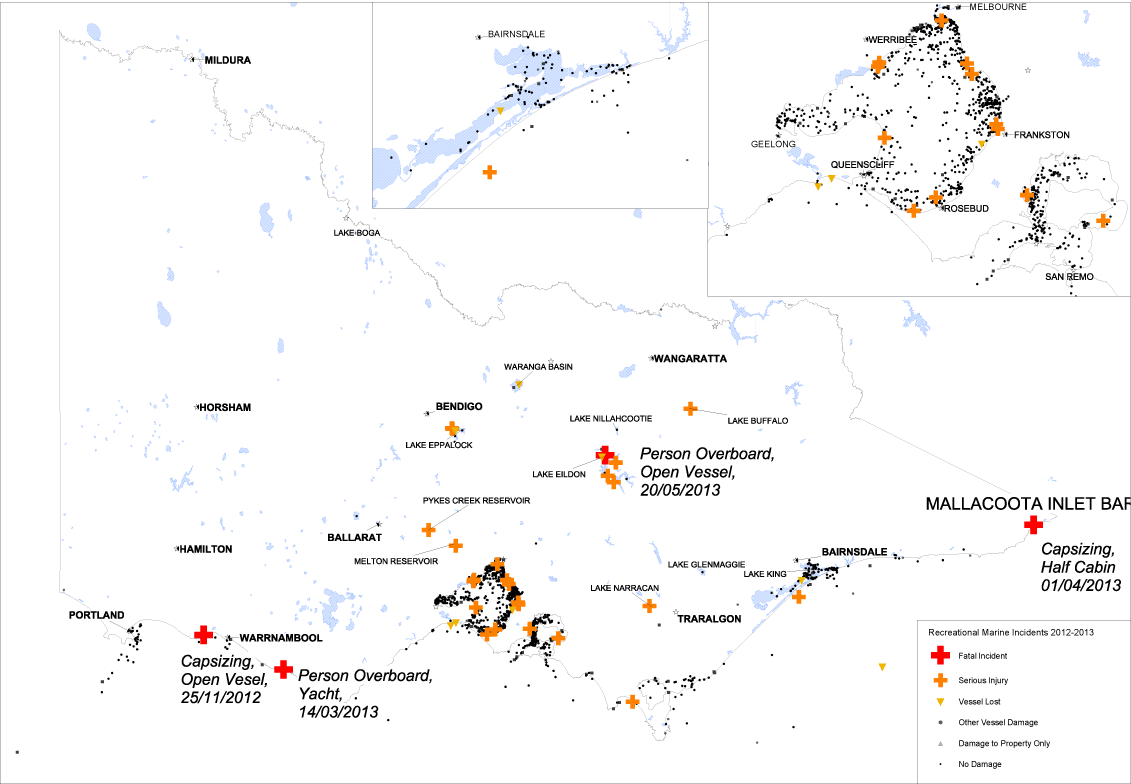
Source: Transport Safety Victoria.
1.4 Audit objective and scope
The objective of the audit was to assess the effectiveness and efficiency of the state's marine safety regulatory framework in minimising safety risks for recreational maritime uses.
The audit examined TSV in its role as the state's regulator of recreational maritime safety and as a waterway manager. A sample of five additional waterway managers was also examined—Department of Environment and Primary Industries, Parks Victoria, Goulburn-Murray Rural Water Corporation, Gippsland Ports Committee of Management and Gannawarra Shire Council.
Collectively, the six waterway managers are responsible for 47 per cent of Victoria's 184 managed waterways, including all waterways where the level and nature of existing recreational use poses a high risk to safety. Figure 1C provides an overview of the audited waterway managers.
Figure 1C
Overview of audited waterway managers
|
Waterway manager audited |
Number of waterways and key characteristics |
|---|---|
|
Parks Victoria |
Three rivers, two lakes, an area of Bass Strait and the three local ports of Port Phillip, Western Port—the state's two most popular ports—and Port Campbell. |
|
Department of Environment and Primary Industries |
Thirty-six inland rivers/lakes located across the state. |
|
Gippsland Ports |
Seven waterways including the five local ports of Corner Inlet and Port Albert, Port of Gippsland Lakes, Port of Anderson Inlet, Port of Snowy River and Port of Mallacoota Inlet. |
|
Goulburn-Murray Rural Water Corporation |
Fourteen water storage areas holding 70 per cent of Victoria's stored water, some of which are also popular for recreational activities, such as Lake Eildon. |
|
Gannawarra |
Three lakes and one creek, including Lake Charm where statewide ski racing competitions are held. |
|
Transport Safety Victoria |
Twelve waterways, including many popular areas such as Anglesea and Torquay along Bass Strait. |
Source: Victorian Auditor-General's Office.
DTPLI's role in coordinating the development of regulatory policy and legislation advice relating to maritime safety was also examined.
The audit also examined how the related enforcement activities of Victoria Police were informed by and aligned with TSV's regulatory framework.
The audit did not examine the management of commercial maritime safety risks and the associated role of port management bodies, as this is regulated by the Commonwealth Government.
1.5 Audit method and cost
The audit used desktop research, document and file reviews, and interviews with agency staff and stakeholders.
The audit was conducted in accordance with the Australian Auditing and Assurance Standards. Pursuant to section 20(3) of the Audit Act 1994, unless otherwise indicated, any persons named in this report are not the subject of adverse comment or opinion.
The total cost of the audit was $505 000.
1.6 Structure of the report
The report is structured as follows:
- Part 2 assesses TSV's overall approach to monitoring the marine safety system
- Part 3 examines the identification and management of marine safety risks
- Part 4 examines approaches to achieving compliance with regulatory requirements, including enforcement activities
- Part 5 examines support provided to waterway managers to fulfil their regulatory responsibilities.
2 Monitoring the marine safety system
2 Monitoring the marine safety system
At a glance
Background
As the state's regulator of the marine safety system, the Director, Transport Safety (the Safety Director), through Transport Safety Victoria (TSV), needs access to accurate and reliable information on how well the system is working. The Safety Director also needs to know how well other co-regulators and duty holders are adhering to and enforcing safety standards applicable under the Marine Safety Act 2010 (the Act) and Marine Safety Regulations 2012.
Conclusion
TSV cannot demonstrate that current marine operations and safety management systems are effective, as it has no framework for reliably evaluating this, or for assessing whether duty holders, waterway managers and enforcement agencies are effectively discharging their statutory obligations.
Findings
- TSV does not have adequate arrangements in place to systematically monitor and report on the effectiveness of marine operations, statewide safety management systems and the related performance of duty holders.
- This critical gap means that TSV lacks the information it needs to effectively target and prioritise its regulatory activities.
- TSV and waterway managers have longstanding concerns regarding the lack of funding that have yet to be satisfactorily resolved.
- The Act requires revenues from prescribed fees to be used for boating and related safety purposes. However, there is no public reporting on the collection and use of these funds to provide assurance that existing fee revenue is being effectively and efficiently applied across the marine safety system.
Recommendations
- That the Safety Director systematically assesses and regularly reports on the efficiency and effectiveness of Victoria's marine safety system.
- That DTPLI reviews the adequacy of current resourcing arrangements for supporting effective implementation of the marine safety regulatory framework.
2.1 Introduction
The objects of the Marine Safety Act 2010 (the Act) are to promote:
- the safety of marine operations
- the effective management of safety risks in marine operations and in the marine operating environment
- continuous improvement in marine safety management
- public confidence in the safety of marine operations
- involvement of relevant stakeholders in marine safety
- a culture of safety among all participants in the marine operating environment.
A key measure of the marine safety system's effectiveness, therefore, is how well it controls the safety of marine operations, management of safety risks and compliance with related safety standards.
The Act, the Marine Safety Regulations 2012 (the Regulations) and gazetted waterway rules specify these standards and how they apply to marine activities, safety infrastructure, duty holders and waterway managers.
As the state's regulator of the marine safety system, the Director, Transport Safety (the Safety Director), supported by Transport Safety Victoria (TSV), has a statutory responsibility to effectively coordinate with its co-regulators—waterway managers, Victoria Police, local port managers, port management bodies—to monitor and enforce these standards and assure compliance with the Act and the Regulations.
To discharge these functions effectively, TSV needs access to accurate and reliable information on how well the system is working to achieve the objects of the Act. It also needs to know how well other co-regulators and duty holders are adhering to and enforcing safety standards.
This information is critical to enable TSV to effectively target its regulatory activities and to reliably assess and improve its own performance as a regulator.
This Part of the report examines how effectively TSV monitors the performance of the marine safety system.
2.2 Conclusion
TSV cannot demonstrate that it is effectively and efficiently regulating marine safety, as it has no framework to reliably evaluate this, or to assess whether duty holders, waterway managers and enforcement bodies are effectively discharging their obligations and complying with the Act and the Regulations.
The absence of such arrangements significantly impedes TSV's accountability for performance, including its ability to effectively regulate safety. Consequently, TSV cannot assure Parliament, the Minister for Ports or the community that its current approach to regulating marine safety is working.
These deficiencies, coupled with longstanding funding concerns by TSV and waterway managers means that there is insufficient assurance that state funds are being effectively and efficiently applied across the marine safety system.
2.3 System-wide monitoring arrangements
The Safety Director has a range of statutory responsibilities that create a strong imperative for monitoring the performance of the marine safety system in achieving the objectives of the Act. These include:
- monitoring compliance with marine safety laws
- making appropriate waterway rules
- registering vessels and licensing vessel operators
- developing and enforcing appropriate standards for navigation, maritime safety and related infrastructure
- coordinating and supporting the implementation of the Safety Director's Marine Enforcement Policy by members of the police force, transport safety officers and any persons employed or engaged by port management bodies, local port managers and waterway managers.
The Safety Director has no explicit function under the Act to oversee waterway managers. The then Department of Transport's 2009 review of the former Marine Act 1988 recognised that most of the above functions nevertheless require the Safety Director to exercise a level of oversight.
TSV undertakes a range of activities in these areas. However, its existing monitoring arrangements do not enable the Safety Director to assess whether all these responsibilities are being effectively and efficiently carried out. TSV advised it has recently worked to strengthen accountability provisions for its outsourced registration and licensing services.
While TSV has procedures in place for auditing waterway managers and reporting on marine incidents, there are no defined performance targets or documented arrangements for monitoring, assessing and reporting on the effectiveness of the wider marine safety system.
TSV's monitoring is currently limited to public reporting on such activities as the number of audits undertaken of maritime training providers, proportion of safety incidents investigated, and number of recreational vessels inspected. TSV also reports on the type and location of safety incidents across the state's waterways.
Notwithstanding this, these measures offer little insight into the extent to which duty holders and co‑regulators adequately discharge their statutory responsibilities, or the impact of TSV's system-wide monitoring and enforcement efforts.
This critical gap means that TSV lacks the information needed to effectively target and prioritise its education, stakeholder engagement, compliance monitoring and related enforcement activities.
It is important to note that the new regulatory framework is in the early stages of implementation and therefore its impact on longer-term safety outcomes cannot yet be reliably assessed. However, there is an urgent need for data and shorter-term indicators focusing on the immediate performance of the system and its key participants in managing safety risks and achieving compliance with marine safety laws to enable TSV to focus and prioritise its regulatory activities.
This audit identified that there is a pressing need for TSV to establish such arrangements, as there is little assurance that:
- TSV and all waterway managers adequately assess and manage recreational maritime safety risks in accordance with the Act
- safety education and promotion activities are adequately informed by reliable data on current trends in the safety of marine operations, performance of safety management systems and impact of previous education initiatives
- critical safety controls—including navigation aids, signage and waterway rules—are fit for purpose, adequately address current risks, and comply with the Act
- enforcement activities are sufficient, effectively coordinated amongst co‑regulators and adequately targeted based on reliable information on risks
- current funding arrangements are sufficient to support effective implementation of the regulatory framework
- TSV is effectively prioritising its regulatory activities to optimise the impact and use of its limited resources.
These critical shortcomings, discussed further in Parts 3, 4 and 5 of this report, mean there is currently little evidence to demonstrate that TSV, duty holders and co‑regulators are effectively implementing the regulatory framework and achieving the objectives of the Act.
In October 2013, TSV started work to establish a more comprehensive framework for benchmarking its regulatory performance by measuring the costs and benefits of its regulatory work, along with its efficiency and effectiveness. However, TSV has not yet set a time line by which this is to be achieved.
2.4 Funding arrangements for marine safety management
TSV and waterway managers have longstanding concerns regarding the lack of funding, which have yet to be satisfactorily resolved. This has been consistently raised by them as a critical issue impeding their ability to effectively discharge their legislative responsibilities. TSV has also indicated that, based on its experience, the capacity and willingness of waterway managers to discharge their statutory functions appears directly proportional to their allocated funding, which in most cases is minimal.
2.4.1 Optimising the use of available funding
The funding for recreational maritime safety is derived from state appropriations that can include fees charged for licensing and registration of recreational vessels and operators. The revenue collected from these fees forms part of the state's consolidated revenue administered by the Department of Treasury and Finance and is allocated through the annual Budget process.
Under the Act, including the former Marine Act 1988, all prescribed revenue from these fees must be used by any person, authority or organisation approved by the Minister for Ports for the:
- provision and maintenance of boating facilities and services for the public
- conduct of boating safety, education and promotion programs for the public.
Although under the Regulations only registration revenue is currently prescribed for these purposes, the Department of Transport, Planning and Local Infrastructure (DTPLI) advised that the manner in which it has previously recorded the use of these revenues has encouraged a long-held misconception by DTPLI that licensing revenue must also be used for boating facilities and related safety programs.
Consequently, we found that DTPLI records do not provide sufficient information to reliably acquit the use of registration fee revenues.
Specifically, Figure 2A indicates that $103 million of the $201 million in licensing and registration fee revenue collected from the sector between 2001–02 and 2012–13 was from registration fees, and that total allocations to enforcement activities and from the Boating Safety and Facilities Program (BSFP), administered by DTPLI, during this period amounted to $10.8 million and $56.5 million respectively.
Figure 2A
Fees for boating facilities and safety education, 2001–02 to 2012–13
|
Item |
Total ($ million) |
|---|---|
|
Revenue |
|
|
Boating registration |
102.81 |
|
Licence fees |
98.16 |
|
Expenditure |
|
|
Collection costs |
41.72 |
|
Enforcement |
10.82 |
|
BSFP |
56.50 |
Source: Victorian Auditor-General's Office based on data supplied by the Department of Transport, Planning and Local Infrastructure.
However, DTPLI advised that it cannot confirm the difference between fee revenues collected from and expended in the sector. This is because its records are based on an assumed, notional allocation of these fees to its related programs, given that they are not separately identified in annual appropriations received through the Budget process.
DTPLI advised that the state's expenditure in the marine sector over this period has exceeded fee revenues collected when annual expenditure via the BSFP and its Local Ports Program is considered. DTPLI's Local Ports Program provides annual funding of approximately $11 million to local ports for land and marine infrastructure, and for related shipping and boating activities, but this does not extend to all non-port-related waterways. Additionally, annual allocations from the BSFP between 2005–06 and 2012–13 were approximately $5 million, and will increase by a further $3 million from 2014–15.
While it is evident that this expenditure has occurred, DTPLI acknowledges it cannot formally acquit that all boating registration revenue has been fully expended in accordance with the Act as it does not maintain detailed records of expenditure by port managers.
Proposed funding allocation
A February 2011 briefing from the former Department of Transport to the then Minister for Ports advised of a discrepancy between revenue collected and revenue allocated to the marine sector from the Consolidated Fund.
The then Minister for Ports wrote to the then Treasurer in February 2011 highlighting that the funding challenges faced by local ports had contributed to a significant backlog of required infrastructure works. The minister further advised of his intention to make a submission to the Budget and Expenditure Review Committee seeking its approval for a proposal to allocate all boating registration and licensing fees revenues, net of collection costs, from 2011–12 to the BSFP and Local Ports Program, which both support recreational boating.
DTPLI advised that this proposal was not supported, and thus it did not proceed for consideration by government.
This situation, coupled with the aforementioned deficiencies in statewide monitoring arrangements, means that there is insufficient assurance that existing fee revenue is being effectively and efficiently applied across the marine safety system.
Ongoing concerns about the adequacy of funding to TSV and waterway managers means that urgent action is needed by DTPLI to address this situation and review—in consultation with the Safety Director and central agencies—the adequacy of current resourcing arrangements underpinning the regulatory framework.
2.4.2 Funding to waterway managers
Under the Act, waterway managers are responsible for managing safe vessel movements by establishing and ensuring compliance with boating safety signage, aids to navigation and vessel operating and zoning rules, including temporary rules for mitigating safety risks during water events.
However, TSV has identified that most waterway managers do not consider these tasks form part of their core business as they are not externally funded to undertake them.
Among waterway managers, only port management authorities and local port managers appointed under the Port Management Act 1995 receive funding to carry out these activities in relation to ports under their control. However, it is important to note that this funding does not extend to any inland or other non-port-related waterways they may also be responsible as the designated waterway manager under the Act.
Consequently, most agencies perceive that their appointment by the state as a waterway manager creates a significant and ongoing unfunded liability to establish and maintain expensive safety infrastructure. This is in addition to the unfunded cost of acquitting their statutory obligations to manage safety risks and make sure waterway users comply with the Act and the Regulations.

Starboard mark near Mordialloc Pier marking the entrance to Mordialloc Creek. Note special mark in the background delineating 5 knot zone. Photograph courtesy of Parks Victoria.
Figure 2B illustrates that this is a longstanding issue that has yet to be resolved.
Figure 2B
Limited resources to support waterway management
|
In its July 2009 review of the former Marine Act 1988 the then Department of Transport noted that due to the difficulties and cost inherent in waterway management, and the responsible bodies being ill-equipped to perform it, many managers were carrying out their functions reluctantly. Although it was thought that local community groups would have an interest in managing the use of waterway resources for the benefit of the local community, stakeholder consultations identified that most perceived the cost of performing the role as too high, relative to the benefit. Some options to increase revenue for waterway managers were considered—such as increasing the fees paid by waterway users and directing some or all of it back to waterway managers—but these were not adopted, primarily due to strong opposition from key stakeholders in the boating industry. Instead, the reluctance of some waterway managers was accommodated in the Act by making the role voluntary and limiting their civil liability. However, this has not addressed their fundamental concerns regarding funding. |
Source: Department of Transport discussion paper, July 2009, Improving Marine Safety in Victoria—Review of the Marine Act 1988.
The only funding source for most waterway managers is available through the annual $5 million BSFP administered by DTPLI. The BSFP allocates small grants to eligible agencies, including waterway managers, mainly for the installation of boat ramps and jetties, for which approximately $3.4 million was allocated in 2012–13. This typically leaves only a very small amount for improving navigational aids and boating safety signage, for which approximately $425 000 was allocated in 2012–13.
Access to BSFP funding relies on applicants providing a co-contribution ranging from 20 per cent for boating infrastructure projects to 90 per cent for the installation of aids to navigation.

Boating zone mark off Frankston Pier. Note special mark delineating 5 knot zone Photograph courtesy of Parks Victoria.
TSV and the examined waterway managers advised that this limited pool of funds is therefore not sufficient to adequately support the statutory duties of most waterway managers.
For example, TSV advised the Safety Director in October 2013 that it required a further $104 500 to rectify issues of noncompliance with safety regulations in relation to the 12 waterways under its control, despite reallocating internal funds and receiving funding of $145 000 through the 2013–14 State Budget.
A TSV briefing to the Minister for Ports in October 2013 highlighted that as waterway managers have limited funding, they have limited capacity to fulfil their role and, thus, properly manage related risks. The briefing also highlighted that there are significant issues if a waterway is not actively managed, namely:
- inadequate/deteriorating navigation aids and signage
- inadequate zoning to separate different types of activity
- no understanding of risks
- poor compliance with rules
- increased risks from floating debris or submerged objects
- no oversight of waterway events.
The briefing explained that where there is no appointed waterway manager, TSV may assume the responsibility for managing safety risks. Although this is the case with the vast majority of Victoria's coastline, TSV considers itself to be inadequately resourced to manage this responsibility.
Despite these risks, it is not evident that TSV has been proactive in rigorously analysing the funding gap for waterway managers. In preparing a 2013–14 Budget submission, TSV initially included a funding request for waterway managers which did not make it into the final submission to government. Our review of the draft document found it lacked the robust analysis required of a business case. Specifically, it did not analyse the risks and implications for marine safety arising from identified noncompliant infrastructure, or consider alternative cost-effective options for mitigating these risks.
2.4.3 Funding to Transport Safety Victoria
TSV advised that it receives insufficient funding to properly discharge its regulatory functions. While lack of funds could impede effective implementation of the regulatory framework, shortcomings in TSV's performance monitoring arrangements mean that it cannot presently demonstrate that its existing resources are being effectively applied.
TSV's operating budget for maritime safety in 2013–14 was $13.4 million, comprising:
- $5.2 million to VicRoads for registration and licensing services
- $0.65 million to Victoria Police for enforcement services
- $4.8 million for salaries
- around $2.8 million for fixed costs.
In 2011 TSV also received an additional $790 000 to support its implementation of the Act and a one-off payment of $250 000 to implement related changes to its business processes including upgrading its information technology systems.
However, a July 2012 internal TSV analysis of resourcing issues identified around $4.4 million in unfunded deliverables considered essential for carrying out its regulatory responsibilities. This included an estimated $1.2 million for implementing the Act in 2012–13 and around $740 000 for implementing the national scheme for commercial vessel safety—with the bulk of the remaining shortfall attributed to new and expanded regulatory functions covering compliance monitoring, incident investigations, education activities, waterway rule-making and audits of waterway managers.
However, TSV's estimate of additional funds required was not presented in the context of an analysis of how effectively its current resources are being applied. This means that the basis of its estimated funding shortfall cannot be reliably and transparently assessed.
TSV submitted a revised business case in 2013–14 for additional state funding of $22.8 million over four years to address some of the above issues, however, it was unsuccessful. Specifically, it received only $1.1 million in 2013–14, comprising a $900 000 funding contribution to the Commonwealth Government for administering the national system for commercial vessel safety on state waters, and $200 000 for critical maintenance of navigational aids.
Recommendations
That the Director, Transport Safety:
- develops arrangements to systematically assess and report on the efficiency and effectiveness of Victoria's marine safety system, and related performance of duty holders and co-regulators, and uses this data to target regulatory activities
- reviews management of budgets and financial resources to assure existing funds are effectively and efficiently utilised to optimise regulatory outcomes.
That the Department of Transport, Planning and Local Infrastructure:
- consults with central agencies and the Director, Transport Safety, to review the adequacy of current resourcing arrangements for supporting effective implementation of the marine safety regulatory framework
- investigates options for the effective and efficient use of all existing revenues from the marine sector to improve marine safety management
- reports publicly on the collection and use of revenue from prescribed fees and all other funds it administers for boating safety and facilities to acquit the requirements of the Marine Safety Act 2010.
3 Identifying and managing recreational maritime safety risks
3 Identifying and managing recreational maritime safety risks
At a glance
Background
The Director, Transport Safety (the Safety Director) needs a sound understanding of statewide maritime safety risks in order to effectively prioritise Transport Safety Victoria's (TSV) regulatory activities. Similarly, waterway managers need to accurately understand the nature and severity of prevailing safety risks, the adequacy of associated controls and any consequential impact on their shared responsibility to manage them.
Conclusion
There is little evidence to demonstrate that TSV and waterway managers are effectively identifying and managing recreational maritime safety risks across the majority of the state's waterways.
Findings
- While TSV has a sound approach for assessing risks across the state's managed waterways, its implementation is compromised by critical information gaps and an over-reliance on waterway managers' risk management practices, which are mostly deficient.
- Most of the state's existing waterway rules were established decades ago under the former regulatory arrangements and are not periodically reviewed to assure they remain fit for purpose, effective and support the efficient management of safety risks.
Recommendations
- That waterway managers, in consultation with the Safety Director, establish effective risk management arrangements.
- That the Safety Director strengthens TSV's waterway risk assessments by assuring the quality of information it relies on from waterway managers, estimating the number of unmanaged waterways, cost-effectively assessing risks across the state's unmanaged waterways and systematically reviewing the appropriateness of waterway rules for managing current safety risks.
3.1 Introduction
A key object of the Marine Safety Act 2010 (the Act) is to promote the effective management of safety risks.
The Act establishes that marine safety is the shared responsibility of the Director, Transport Safety (the Safety Director), waterway managers, and all duty holders. Specifically, it provides that the level and nature of their responsibility for marine safety depends on the nature of the risk to marine safety created by their activities or decisions, and their capacity to control, eliminate or mitigate these risks.
As the state's transport safety regulator, the Safety Director through Transport Safety Victoria (TSV) needs to establish a sound understanding of statewide maritime safety risks in order to assess the level and nature of his shared responsibility under the Act to mitigate them, and effectively prioritise his related regulatory activities.
Similarly, waterway managers also need to accurately understand the nature and severity of prevailing safety risks on waters under their control, and any consequential impact on their shared responsibility to manage them.
This Part of the report examines the adequacy of the risk identification and management practices of both the Safety Director and the selected waterway managers.
3.2 Conclusion
There is little evidence to demonstrate that TSV and all waterway managers are effectively managing recreational maritime safety risks.
While TSV has a conceptually sound approach for assessing statewide risks, its implementation is compromised by critical information gaps, an over-reliance on the deficient risk management practices of most waterway managers, and inadequate quality assurance.
Inherent weaknesses in local risk management mean that none of the examined waterway managers could fully demonstrate that all of their waterway users and safety controls comply with the Act and are effective in minimising local safety risks. This includes port management authorities and local port managers whose risk management activities generally do not extend to non-port-related waterways, due in part to limited funding.
Further, while existing waterway rules are a critical component of the state's risk control framework, most were established decades ago under the former regulatory arrangements and are not periodically reviewed to assure their ongoing relevance and appropriateness.
These shortcomings are significant as they mean neither TSV nor most waterway managers can be fully confident about the effectiveness and efficiency of current controls, and the safety of the state's waterways.
3.3 Identifying and assessing waterway safety risks
3.3.1 Transport Safety Victoria's oversight of statewide risks
TSV has developed a conceptually sound waterway risk assessment tool for identifying and assessing risks to safety across the state's managed waterways.
However, critical shortcomings with its implementation mean that TSV cannot be confident it accurately understands the nature or severity of current risks across the state's waterways.
The waterway risk assessment tool considers an appropriate range of relevant data including:
- environmental and physical factors—for example, whether water levels have changed due to wind, irrigation or drought, and whether there are hidden objects in or under the water
- the nature of activities taking place on the waterway—for example, whether high‑speed or multiple activities are likely to occur in the same waterway
- trends in the number and nature of safety incidents and/or related complaints—including requests for assistance with enforcement from the waterway manager
- results of audits of waterway managers' risk controls—for example, whether boating zones are clearly marked and navigational aids are well maintained.

Photograph courtesy of Eileen Hayes.
TSV categorises, assesses and ranks these factors to produce an overall assessment of the residual risk level for each waterway. TSV prioritises waterway managers for future audit activity based on this assessment.
However, administering this risk assessment tool is resource intensive as it requires TSV to manually compile and maintain a large volume of data for all of the state's 184 managed waterways.
TSV advised that due to limited resources, it largely relies on waterway managers to provide up-to-date information on such factors as the changes in water levels, the condition and availability of boating ramps and jetties for accessing the waterway, and related levels of usage. It also advised that it seeks to verify this information through its subsequent audits and informal site visits.
However, this process is not documented, as it is not evident that TSV systematically assures the quality and reliability of such information received from waterway managers. While its audits of waterway managers provide an opportunity to address this issue, as noted in Part 4 of this report, they are not sufficiently regular or detailed in scope to provide the assurance required.
A further shortcoming is that the risk assessment tool does not presently consider the risks across the state's numerous unmanaged waterways. TSV's tool lists 123 unmanaged waterways but for the vast majority contains no risk information.
TSV also confirmed that it did not know the precise number of active waterways in Victoria, as determining an exact figure was difficult at any given time due to the dynamic nature of waterway levels.
Consequently, TSV cannot be assured that it has an accurate and comprehensive understanding of the nature or severity of current safety risks across the state's waterways where boating activity can occur. It is essential for TSV to address this gap to effectively discharge its associated regulatory obligations. TSV has acknowledged this issue and advised it intends to establish arrangements to systematically assure it is aware of where boating activity is currently occurring on unmanaged waterways.
TSV maintains that reliable information on safety risks should be available from waterway managers given that the Act places primary responsibility on them to ensure the safe operations of vessels in waters under their control.
This expectation is reasonable in principle. However, weaknesses in the risk management practices of most waterway managers, coupled with TSV's inadequate quality assurance processes, mean that TSV has no evidence upon which to verify this assumption and assure the accuracy of its own risk assessments.
3.3.2 Waterway managers' oversight of local risks
Procedures for overseeing local safety risks among the examined waterway managers were generally inadequate.
Under the Act and the Marine Safety Regulations 2012 (the Regulations), waterway managers are responsible for managing safe vessel movements by establishing and ensuring compliance with boating signage, aids to navigation and vessel operating and zoning rules, including temporary rules for mitigating safety risks during water events.
Among waterway managers, only port management authorities and local port managers who are appointed under the Port Management Act 1995 (the PMA) to control designated ports receive funding to carry out these activities. However, this funding does not extend to any inland or other non-port-related waterways for which they may also be responsible as the designated waterway manager under the Act. For example, Gippsland Ports Committee of Management's funding agreement is silent on meeting any standards under the Act except for boat ramp signage and navigation aids in two waterways.
We found that no waterway manager had established arrangements for systematically identifying, assessing and monitoring safety risks on all waters in their control under the Act. Goulburn-Murray Rural Water Corporation advised that while it's documented risk assessments do not include boating safety risks, when risks are identified through routine patrols appropriate actions are taken.
Consequently, none of the waterway managers we examined could fully demonstrate that all of their safety controls and recreational waterway users complied with the Act and the Regulations, and that related maritime safety risks were being effectively managed.
Additionally, TSV has identified that most waterway managers do not consider these tasks as part of their core business as they are not externally funded to undertake them. Specifically, TSV's audits of 82 waterways over a three-year period to 2013 found that 85 per cent of the navigational aids and signage at these waterways did not comply with applicable requirements — for example, buoys and safety signage were in the wrong location or signage was incorrect or missing. TSV highlighted that this was in part because waterway managers did not have sufficient resources or the required capabilities to effectively discharge these functions. The potential impact of this on risk management was evident among the waterway managers we examined.
For example, Parks Victoria and the Gippsland Ports Committee of Management had identified and assessed the safety risks for local ports they manage under the PMA and events on high-risk waterways managed under the Act. However, it was not evident that they had done the same for all of the other non-port-related waterways in their control under the Act, which they advised was due to the lack of designated funding.
It is concerning that the audited waterway managers have not fully complied with their legislative obligations, particularly as this has the potential to heighten safety risks to users of those waterways.
TSV advised that the voluntary nature of waterway managers' role, coupled with the fact that they are not duty holders, means it has no capacity to compel them to address shortcomings in risk management.
3.4 Setting and maintaining waterway rules
3.4.1 Purpose of waterway rules
The Safety Director, through TSV, is responsible for determining standards and procedures for navigation and maritime safety on all state waters. Under the Act, the Safety Director has the power to make waterway rules that regulate or prohibit the operation of any vessel, or use of state waters by any person.
There are currently 22 waterway rules in force across all state waters, and many local rules that apply only to specific waterways. These rules aim to provide a safe operating environment, cater for the wide range of popular boating and water activities, and to separate different and potentially conflicting activities on the basis of safety.
These rules form a vital part of the control framework for managing recreational maritime safety risks and typically prescribe a range of matters including:
- speed limits and safety distance requirements applicable to vessel operations—i.e. restrictions on proximity to persons, the water's edge and marine infrastructure
- areas where vessels and recreational users are prohibited
- areas where vessels with engines used for propulsion are prohibited
- conditions on the use of designated waters and/or operation of vessels in specified areas
- restrictions governing the mooring, anchoring or berthing of vessels.
It is therefore important that waterway rules are properly targeted and systematically reviewed to assure they remain relevant to and effective for managing key safety risks.
3.4.2 Assuring the appropriateness of waterway rules
The Act stipulates that a risk-based approach must be taken in developing a waterway rule by taking into account the following 'mandatory considerations':
- the nature and level of a safety risk, and how the proposed rule could minimise or eliminate the risk
- whether there are any other alternatives to address the safety concern
- the expected benefits and costs of the proposed rule for those persons likely to be affected by it, if made.
Most of the current waterway rules were set under the former Marine Act 1988. Since that time it is possible that many waterways, particularly inland rivers and lakes, have experienced substantial changes in their usage and associated risk profile due to circumstances such as flooding, drought and population change.
It is therefore critical for safety rules to be systematically reviewed to assure that they remain fit for purpose and effective, and that they support the efficient management of safety risks.
At a local level, this responsibility primarily rests with waterway managers as it is an important aspect of assessing local safety risks and the adequacy of associated controls.
At a statewide level, TSV needs to assure that waterway managers are satisfactorily undertaking these reviews as it depends heavily on information from them to accurately assess risks.
However, it is not evident that either TSV or waterway managers systematically review the appropriateness of all waterway rules applying to all of their designated waterways. Consequently, there is little assurance that all existing rules adequately address current safety risks.
Under the Act, waterway managers can request the making of a waterway rule by the Safety Director following consultation with the public, including assessment of the mandatory considerations mentioned above. These requests can also be usefully informed by periodic reviews of the ongoing appropriateness of existing rules. However, waterway managers advised that they do not routinely conduct such reviews due to their limited resources and the substantial time and costs involved, which they perceive as a disincentive.
To date, nine waterway managers, including Gippsland Ports Committee of Management and Gannawarra Shire Council, have applied for rule changes on 13 individual waterways under the Act. In addition, Goulburn-Murray Rural Water Corporation has commenced a process to review its current waterway rules, and TSV advised that it has developed eight urgent safety rules since the commencement of the Act. Nevertheless, except in these few cases, the ongoing appropriateness of the waterway rules in responding to current levels of safety risks has not been assessed by TSV or waterway managers, and it is not evident that the above activities are part of a documented program for systematically and comprehensively reviewing statewide and local rules.
TSV does not systematically assess the appropriateness of waterway rules, as it maintains that waterway managers are primarily responsible for managing risks in waters under their control. However, this expectation is not soundly based as it has insufficient assurance of the effectiveness of waterway managers' risk management practices.
This heightens the need for TSV to urgently and proactively review, in consultation with waterway managers, the adequacy of existing rules in order to effectively discharge its obligations as the state's transport safety regulator.
Parks Victoria has been the most active of the examined waterway managers in reviewing and updating the rules for waterways under its control, especially for areas most frequented by recreational users. Figure 3A summarises its actions to improve safety initiated under the former Marine Act 1988.
Figure 3A
Parks Victoria's new boating zones
|
Parks Victoria is the local port and waterway manager for Port Phillip and Western Port bays. In total, the two bays experience around 60 million recreational visits per year and are used for many on-water businesses. In 2008, Parks Victoria, in conjunction with Marine Safety Victoria (now TSV), undertook a comprehensive review of boating zones as it determined they were causing confusion and were being ignored by some users. The review aimed to improve safety and better respond to new and emerging recreational activities by creating more consistent waterway rules and activity zones. In mid-2008, Parks Victoria commenced an extensive consultation program focused on raising public awareness of the proposed changes and on obtaining the input of key stakeholders including Water Police, nearby local governments, Life Saving Victoria and the Boating Industry Association of Victoria. The new boating zones were approved by the Safety Director in December 2009 and have since been progressively implemented across both bays. |
Source: Victorian Auditor-General's Office.
Recommendations
- That waterway managers, in consultation with the Director, Transport Safety, establish effective arrangements to systematically identify, assess and monitor safety risks on waters designated to them for control under the Marine Safety Act 2010.
- That the Director, Transport Safety strengthens Transport Safety Victoria's waterway risk assessment practices by establishing arrangements to systematically:
- assure the quality and reliability of information it relies on from waterway managers to assess marine safety risks
- work with waterway managers to review and estimate the number of unmanaged waterways
- assess risks cost-effectively across the state's unmanaged waterways
- review and assure the appropriateness of existing waterway rules for managing current safety risks.
4 Promoting and enforcing compliance with regulatory requirements
4 Promoting and enforcing compliance with regulatory requirements
At a glance
Background
The Marine Safety Act 2010 provides that responsibility for enforcing marine safety compliance is shared by a number of stakeholders who act as co-regulators in conjunction with Transport Safety Victoria (TSV) to ensure safety through effective compliance monitoring and enforcement. As Victoria's transport safety regulator, the Director, Transport Safety has a critical role to guide, coordinate and assure the effectiveness of system-wide enforcement activities.
Conclusion
The Safety Director's system-wide education and enforcement activities are risk-based and targeted but are compromised by critical information gaps, inadequate cross‑agency coordination and the absence of reliable data that demonstrates their effectiveness in minimising safety risks.
Findings
- TSV has undertaken a range of marine safety education and communication programs, but has yet to rigorously evaluate their impact on improving compliance with marine safety laws.
- TSV has not yet assessed the effectiveness and efficiency of statewideenforcement activities, and there are no governance arrangements or forums through which TSV, Victoria Police and waterway managers can all share risk information and coordinate their related enforcement activities.
- TSV's audits of waterway managers do not adequately assess how effectively they are managing local safety risks.
Recommendations
That the Director, Transport Safety, periodically assesses the impact of system-wide education and enforcement activities on achieving compliance with marine safety laws and strengthens TSV's audits of waterway managers.
4.1 Introduction
Effectively promoting and enforcing compliance with marine safety laws is vital to assuring marine safety and the effective management of related risks.
The Marine Safety Act 2010 (the Act) provides that responsibility for enforcing marine safety compliance is shared by a number of stakeholders, in conjunction with Transport Safety Victoria (TSV), which acts as a co-regulator to ensure safety through effective compliance monitoring and enforcement.
The Director, Transport Safety (the Safety Director), through TSV, is primarily responsible for administering and enforcing marine safety laws. TSV's Regulatory approach policy establishes a graduated approach to marine compliance and enforcement, ranging from education through to punitive measures focused on maximising:
- duty holders' understanding of their legislative obligations
- duty holders' voluntary and consistent compliance with these obligations
- apositive safety culture across the marine sector.
Other key entities responsible for administering and enforcing Victoria's marine safety laws within TSV's framework include:
- Victoria Water Police—responsible for enforcing the Act, Marine Safety Regulations 2012 (the Regulations), waterway rules made under the Act and other state laws relating to marine drug and alcohol regulation
- waterway managers—who can elect to enforce the Act in designated local waterways under their control through the deployment of transport safety officers (TSO) appointed by the Safety Director.
As Victoria's transport safety regulator, TSV is driven by the public interest in marine safety and by the need to assure that duty holders are meeting their legislative obligations in helping to maintain public confidence in the marine safety system. TSV, therefore, has a critical role in coordinating and assuring the effectiveness of system-wide enforcement activities.
This Part of the report assesses whether the compliance and enforcement activities of TSV, Victoria Water Police and waterway managers have been effective.
4.2 Conclusion
TSV's system-wide education and enforcement activities are risk-based and targeted but are compromised by critical information gaps, inadequate cross-agency coordination and the absence of reliable data to demonstrate their effectiveness in minimising safety risks.
While TSV has relied heavily on communication and education activities directed at recreational users to facilitate their compliance, it has not yet rigorously assessed if this outcome is in fact being achieved.
Similarly, TSV depends on the coordinated efforts of multiple agencies to achieve its regulatory outcomes. However, TSV currently has no arrangements for systematically engaging with the majority of port and waterway managers to share risk information, and coordinate their related enforcement strategies with its own and those of Victoria Police.
TSV does not systematically assess the effectiveness of its own enforcement activities, nor seek assurance of the effectiveness of related activities of Victoria Police and waterway managers in achieving regulatory outcomes.
Until TSV addresses these critical shortcomings in its regulatory approach, it cannot be confident that system-wide compliance and enforcement activities are efficiently and effectively targeted, and minimise recreational maritime safety risks.
4.3 Promoting voluntary compliance
Communication and education activities directed at recreational waterway users have been a longstanding feature of TSV's approach to promoting compliance with marine safety legislation. Victoria Police and some waterway managers have also been active in communicating safety messages to the public.
These activities have usually focused on addressing unsafe behaviours by improving waterway users' awareness of the safety risks and their related obligations.
Although TSV has targeted its education and communication programs based on known safety risks, it has yet to rigorously evaluate their impact on improving recreational users' behaviour and compliance.
TSV advised that it acknowledges the importance of evaluation but it is highly dependent on limited and contestable grants from the Boating Safety and Facilities Program for education activities, which limits its capacity to undertake evaluations.
4.3.1 TSV's education and communication activities
The Victorian Recreational Boating Safety Handbook is TSV's key mechanism for educating the public on the key elements of boating safety. The handbook, which is updated annually, details the regulatory obligations of recreational boat users, and is also used as a study reference by marine licence applicants. TSV distributes the handbook to boaters through boat shows, club seminars and other events, and also makes a copy available to the public on its website. The handbook is also available at VicRoads offices and from some waterway managers.
TSV has also been active in communicating safety messages via quarterly newsletters, media releases, and targeted education campaigns. Key educational activities to date have included:
- TSV's Boating Safety Education Officer Program, which provides safety education and guidance to recreational boaters. Since 2008–09, the program has targeted high‑risk waterways based on such factors as weather conditions, tides, reported safety incidents and levels of use.
- Seminars for fishing and boating groups on safety rules and laws applicable to operators and recreational users. In 2012–13, 21 seminars were delivered against a target of 25.
- A 2012–13 education campaign that focused on personal watercraft (PWC) safety after TSV identified increasing numbers of safety incidents involving PWCs. The campaign sought to make PWC operators more aware of their responsibilities and accountable for their on-water behaviour through targeted enforcement.
- A campaign that highlighted the emerging safety risks from paddle sports such as canoeing and kayaking, following six related fatalities over a two-year period to January 2013. TSV communicated the safety message to both the general public and purchasers of such vessels through its 2012–13 summer safety education program. TSV also used its on-water compliance teams to check that vessel users were wearing required safety jackets and carrying the prescribed safety equipment.

Impact of education and communication activities
TSV advised that each year it determines the focus of its education and communication activities, taking into account safety incidents, complaints, feedback from police and waterway managers, including media reports and its observations of recreational user behaviour.
However, apart from limited internal reviews and some positive anecdotal evidence relating to its campaigns, TSV has not yet rigorously evaluated the effectiveness of its communication and education programs. Consequently, TSV cannot reliably demonstrate the impact of these initiatives on improving compliance with applicable marine safety laws.
TSV advised that it is unable to fund the cost of such evaluations due to its limited resources. However, as noted in Part 2 of this report, TSV has yet to demonstrate that it is effectively prioritising its existing funds.
4.3.2 Waterway managers
Encouragingly, Parks Victoria, Gannawarra Shire Council, Gippsland Ports and Goulburn-Murray Rural Water Corporation have also undertaken activities to educate boaters about recreational maritime safety requirements.
These activities have mainly been limited to using their websites to inform the public of upcoming changes to waterway rules and of special events. Goulburn-Murray Rural Water Corporation also distributes a newsletter to houseboat owners, marinas and clubs at least annually, including boating and facilities maps to waterway users, and Gannawarra Shire Council occasionally meets with local stakeholder groups to discuss boating safety requirements. Parks Victoria advised it has, for many years, attended the annual Melbourne Boat Show and provided information about safe boating to waterway users.
However, it is not evident that these initiatives are risk-based, targeted or informed by systematic analysis of relevant data, nor is it evident that these waterway managers systematically assess the effectiveness of these activities to inform their future actions.
4.3.3 Victoria Police
Victoria Police has also undertaken targeted education campaigns before each boating season. Its key activities have included issuing joint media releases with TSV, posting information on its website and participating in radio programs to alert the public about water safety, regulations around boating and enforcement activities.
However, it is not evident these activities are systematically coordinated with or informed by waterway managers, or that they are periodically evaluated in consultation with TSV to assess their impact on regulatory outcomes.
Consequently, there is little evidence to demonstrate that TSV, waterway managers and Victoria Police are working effectively as part of an integrated system of co‑regulators to promote compliance with safety obligations and minimise related risks.
4.4 Enforcing compliance
4.4.1 TSV's Marine Enforcement Policy
TSV's statewide Marine Enforcement Policy (MEP) sets out the guiding principles and decision-making criteria for the use of enforcement and compliance monitoring tools by enforcement agencies and officers.
The MEP clarifies that the state's marine compliance and enforcement activities are aimed at maximising duty holders' understanding and voluntary compliance with their legislative obligations, and the adoption of a positive safety culture. It prescribes a graduated and integrated approach to enforcement, involving information provision and education in the first instance, followed by a range of graduated sanctions, such as infringement notices and ultimately prosecution.
The Act required TSV to develop and implement the MEP within 12 months of the Act becoming operational. The Act also required TSV to consult with relevant stakeholders, including those parties involved in jointly enforcing compliance.
TSV has not met these requirements. Specifically, it finalised the MEP on 17 October 2013—around three months after the legislated time line. TSV advised that this was due to its limited resources and the competing demands imposed on its staff due to concurrent changes in the national scheme for the regulation of commercial vessels in which TSV also has a role.
Further, while TSV undertook limited consultation with Victoria Police, the Boating Industry Association of Victoria and Parks Victoria, it did not actively consult with the majority of other waterway managers.
TSV instead sent an email to all waterway managers in August 2013 advising that the draft policy was available on its website for their review and comment for a period of 28 days. However, beyond this, TSV did not actively seek assurance from waterway managers that they were aware of and understood the draft policy prior to finalising it. Apart from Parks Victoria, other waterway managers we consulted advised they only became aware of the MEP when prompted by this audit.
The limited consultation with waterway managers on the MEP is a missed opportunity because it means TSV cannot be confident that waterway managers adequately understand their roles, including how they can use enforcement options to support their critical role in regulating the safety of boating activities and events on their waterways.
TSV advised that a wider consultation process may have been undertaken had its resources been greater.
4.4.2 Adequacy of enforcement
Transport Safety Victoria
While past TSV enforcement activities have been risk-based, targeted and coordinated with those of Victoria Police, there are critical weaknesses that undermine its general approach. Specifically:
- TSV's enforcement actions are risk-based,however, concerns with the quality and reliability of its underpinning risk assessments mean that TSV cannot be confident that its enforcement actions are adequately targeted.
- While the MEP acknowledges enforcement is carried out by several entities and the importance of a multi-agency approach, TSV has yet to establish arrangements for assuring effective cross-agency coordination. Specifically:
- There are no governance arrangements or established forums for TSV, Victoria Police, port managers and waterway managers to all share risk information and coordinate their related enforcement activities. TSV advised that its request for the Act to be amended to allow for information sharing has not progressed.
- TSV initiated monthly meetings with Victoria Police in October 2013 to strengthen its working partnership and related compliance activities, however, other enforcement bodies are excluded.
- TSV advised that most enforcement occurs on high-use waterways such as Port Phillip Bay as this is where most incidents occur. Consequently, while it also deploys resources to other high-risk locations, enforcement at less populated high-risk locations is limited and largely dependent on available resources.
- TSV has yet to assess the efficiency and effectiveness of system-wide enforcement activities.
These weaknesses mean TSV cannot demonstrate or be confident that current approaches to enforcement by responsible agencies are adequately coordinated, efficient and effective in achieving compliance with marine safety laws.
TSV asserts that the idea of coordinated enforcement activities ignores the reality that waterway managers must target specific risks which are relevant to their waterway. TSV therefore encourages waterway managers to target their education, compliance and enforcement activities in ways that address the risks that they see as being relevant to their waterways, as it considers they are best placed to manage those risks.
However, this notion is not soundly based as it incorrectly implies that there are no common or similar risks across waterways that would benefit from a coordinated approach or from the sharing of insights on the effectiveness of different management approaches. For example, Victoria Police acknowledges that enhanced access to and coordination of risk information from waterway managers would assist its targeting of related enforcement activities.
Further, improved coordination of the sharing of risk information and related enforcement strategies between TSV, Victoria Police and waterway managers can:
- enhance intelligence on the existence and nature of prevailing safety risks across all state waters
- provide valuable insights to waterway managers and TSV on how to improve the effectiveness and efficiency of approaches to manage common and similar risks
- enhance the targeting of Victoria Police's statewide enforcement actions by enabling its risk assessments to be informed by systematic input from all waterway managers
- allow TSV the opportunity to assess whether the combined activities of agencies are consistent, effective and efficient and are achieving the desired regulatory outcomes.
Victoria Police
Victoria Police has a conceptually sound enforcement framework. Key enforcement actions are targeted, taking into account information such as safety incidents, infringements issued, weather patterns and the risk profile of waterway activity, including reports from the public.
Despite this, weaknesses in TSV's cross-agency coordination mean there are key information gaps that can limit the targeting of Victoria Police's enforcement actions. Specifically, Victoria Police's current risk assessments are not informed by systematic input from all waterway managers and TSV on the status of current and emerging safety risks across all managed waterways.
Therefore, unless an individual waterway manager takes the initiative to proactively engage with Victoria Police on an emerging risk, Victoria Police may not become aware of it.
Waterway managers
The Act provides waterway managers with the option of deploying a TSO to carry out enforcement activities.
While doing so is discretionary for waterway managers, this option is sometimes necessary to effectively discharge waterway management functions, particularly as they relate to the control and management of vessel movements and activities.
However, most waterway managers have not activated this enforcement option. Parks Victoria undertakes limited enforcement in the local ports for which it is funded under the Port Management Act 1995 and at events on other waterways but would undertake more enforcement if it was better resourced to do so. All other examined waterway managers advised that they have insufficient resources to undertake compliance and enforcement activities.
Gippsland Ports advised it has chosen not to undertake enforcement activities because its funding arrangements do not provide for such activities, and because of its view that TSV does not provide adequate TSO training and support. Gippsland Ports also advised the cost of engaging TSOs on weekends and public holidays can be prohibitive because penalty rates apply.
TSV similarly advised that the limited resources of waterway managers create a disincentive for them to undertake enforcement and that they may not have the capabilities, or access to the resources needed to support them to contest any legal challenges that may arise.
This means that there is little assurance that the discretion currently being exercised by waterway managers adequately reflects the need for enforcement, or supports the effective discharge of waterway management functions, including management of safety risks.
TSV advised that the voluntary nature of waterway managers' role, coupled with the fact that they are not duty holders, means that it has no capacity to compel them to be more active.
However, TSV has no arrangements in place to systematically assess and mitigate the regulatory risks arising from this situation. Waterway managers indicated that in most cases they normally request assistance with enforcement from Victoria Police. However, Victoria Police is only likely to respond if it perceives there to be a significant safety risk and has resources available at the time of the request. Resources can be limited, especially during peak periods. As a result, most waterway managers advised they experienced limited support.
4.5 Assessing waterway managers' compliance
As the state's transport safety regulator, TSV audits waterway managers' compliance with the requirements to maintain safety infrastructure, such as navigational aids and signage, in accordance with TSV's standards and the Act.
Since the breaking of the drought in 2009–10, TSV has audited 82 waterways managed by 36 waterway managers—averaging about 20 per year. In 2012–13, TSV undertook 17 such audits against the target of 20. TSV explained that this result was due to the re-prioritisation of resources to implement the Act.
TSV's audits are targeted based on its Waterway Risk Assessment Tool. However, TSV advised that due to resource constraints its audits are limited, only covering the main responsibilities of waterway managers, including whether:
- current waterway rules, navigational aids and signage comply with the Act
- waterways have adequate general boating safety information.
TSV also advised that it is not currently resourced to undertake technical audits that require geospatial and mapping skills to verify that navigational aids and waterway zoning comply with published rules. It advised that undertaking these audits requires contractors to be engaged at significant cost to TSV.
A key limitation of TSV's current audits is that they do not systematically assess the effectiveness of waterway managers' risk management practices. Instead, these assessments are typically gleaned through TSV's ad hoc interactions with waterway managers or following safety incidents. Consequently, it is not evident that TSV's audits provide adequate insights into the effectiveness of waterway managers.
TSV does not provide its audit reports to waterway managers in a timely manner, and in one extreme case there was a two-year gap between it completing the audit and issuing the report. TSV explained this was partly due to resource constraints and partly due to the particular waterway manager not responding to TSV's previous audit reports.
TSV advised that due to its limited resources it does not follow up on whether its audit reports are actioned, or require waterway managers to provide an acquittal. Consequently, TSV cannot reliably assess whether waterway managers have implemented remedial actions to appropriately manage previously identified safety risks and thus effectively discharge its obligations as the state's regulator of transport safety.
Some waterway managers, after successfully obtaining funding from the Boating Safety and Facilities Program, acted to rectify the issues the TSV audit reports identified. Those waterway managers that were reluctantly performing the role advised that they were less inclined to go through such a process or do anything to rectify noncompliance, resulting in recreational users remaining exposed to safety risks.
Recommendations
That the Director, Transport Safety:
- periodically assesses the impact of Transport Safety Victoria's communication and education activities on achieving compliance with marine safety laws
- periodically assesses the effectiveness of Transport Safety Victoria's and co‑regulators' enforcement activities—including the impact of the discretionary involvement of waterway managers in enforcement—on achieving desired regulatory outcomes
- broadens Transport Safety Victoria's audits of waterway managers to assure they provide adequate insights into the effectiveness of their risk management practices
- periodically follows up on Transport Safety Victoria's audits of waterway managers to assure that required remedial actions to improve marine safety have been satisfactorily addressed.
5 Supporting waterway managers
5 Supporting waterway managers
At a glance
Background
The Director, Transport Safety (the Safety Director) has a key role, through Transport Safety Victoria (TSV), to support waterway managers to effectively perform their co‑regulatory responsibilities in implementing Victoria's marine safety regulatory framework.
Conclusion
TSV does not know whether current waterway manager appointments remain appropriate or how well their capabilities match the requirements of the role. As a result, it has little certainty its guidance and training adequately meets their needs.
Findings
- TSV does not routinely assess the capabilities of appointed waterway managers, despite its ongoing concerns. Most current appointments have not been reviewed since they were initially made almost 25 years ago.
- TSV has not determined the key capabilities required by waterway managers to undertake their legislative responsibilities nor has it formally assessed the skills and knowledge of current waterway managers against those responsibilities.
- TSV's approach to providing guidance and training to both waterway managers and transport safety officers has been largely reactive and limited.
Recommendations
That the Safety Director, in consultation with the Department of Transport Planning and Local Infrastructure:
- defines the minimum competencies and capabilities of waterway managers
- implements a waterway manager capability framework to inform both the support to waterway managers and advice to the Minister for Ports on their appointment and/or reappointment.
5.1 Introduction
Waterway managers have a critical role in implementing Victoria's marine safety regulatory framework. They provide and maintain related safety infrastructure and, as co-regulators, can make safety rules and elect to enforce them through the deployment of transport safety officers (TSO).
The Director, Transport Safety's (the Safety Director) functions, supported by Transport Safety Victoria (TSV), include developing marine safety standards, guidelines for managing safety risks and a marine enforcement policy to support compliance with marine safety laws.
Because waterway managers' role is voluntary and their limited funding can act as a disincentive, TSV has a key role to play in supporting waterway managers to effectively administer their responsibilities. In order to effectively discharge this role, TSV needs to determine the capabilities required by waterway managers to fulfil their responsibilities, identify current gaps in these capabilities and then address these with targeted training, guidance and support.
This Part of the report examines how well TSV supports waterway managers to fulfil their role as co-regulators of marine safety.
5.2 Conclusion
TSV cannot be assured it is effectively supporting waterway managers to fulfil their co‑regulatory functions. In particular, TSV does not know whether current appointments to the waterway manager role remain appropriate, or how well their capabilities match the requirements of the role. This means TSV has little certainty that the guidance and training it provides meets the needs and priorities of waterway managers.
These shortcomings need to be addressed by TSV, as failure to properly support waterway managers has the potential to compromise the overall effectiveness of the state's marine regulatory framework.
5.3 Assessing the capabilities of waterway managers
Under the Marine Safety Act 2010 (the Act), waterway managers are responsible for managing safe vessel movements by establishing boating safety signage, aids to navigation and vessel operating and zoning rules, including temporary rules and work permits for mitigating safety risks during water events and marine operations.
The absence of any explicit criteria or systematic process for periodically assessing whether waterway managers possess the necessary capabilities means TSV has little assurance that current appointments are soundly based. While the Minister for Ports is responsible for appointing waterway managers, the Transport Integration Act 2010 empowers the Safety Director to make recommendations to the minister on the operation, administration and enforcement of the Marine Safety Act 2010 and associated Regulations. Better knowledge of waterway manager capabilities could therefore inform any related recommendations from the Safety Director to the minister. It would also aid TSV's targeting of its current support activities to waterway managers.
5.3.1 Appointment
Under the Act, the Minister for Ports may declare the Safety Director or any person or agency to be a waterway manager for a designated waterway, generally for five years, subject to them agreeing to the appointment.
The current waterway managers were initially appointed under the former Marine Act 1988, and these arrangements were continued under the current Act. TSV recognised that reappointing existing waterway managers without assessing their capabilities was a potential risk. However, it did so to avoid delaying implementation of the Act, recognising that not reappointing waterway managers could have resulted in poorer safety outcomes, and that appointments along with associated capabilities could be reviewed at a later time.
We found that five waterway managers who had either resigned or intended to resign had done so in part because they did not perceive the role aligned with their organisation's core functions.
Although the Department of Environment and Primary Industries (DEPI) is the appointed manager for 36 waterways, it does not acknowledge that it is a waterway manager for the purposes of the Act. As a result, DEPI has not responded to TSV's correspondence regarding the results of the 11 audits of DEPI's waterways that TSV undertook between 2008 and 2011. DEPI has also not taken any corrective action to address TSV's audit findings as it considers this to be outside of its core responsibilities. TSV acknowledged this is a longstanding issue and advised that it has worked to support DEPI to continue in the role.
Prompted by this audit, in February 2014 DEPI wrote to the Department of Transport, Planning and Local Infrastructure (DTPLI) seeking to discuss the suitability of its appointment as a waterway manager. DEPI offered to work in partnership with DTPLI and TSV to identify the most appropriate waterway managers for its 36 waterways, and the mechanism for the transfer of these responsibilities.
As the majority of waterway appointments occurred in 1988, it is now possible that the synergies that existed previously with respect to the responsibilities of waterway managers may no longer exist. For example, some inland rivers and lakes may now have reduced water levels due to the prolonged drought, and organisations previously appointed as waterway managers may have lost staff with waterway manager knowledge.
Nevertheless, TSV does not proactively undertake periodic assessments of the ongoing suitability of an appointed waterway manager.
5.3.2 Capabilities
At the time of developing the Act, the former Department of Transport considered incorporating capability criteria in the legislation to guide the appointment of waterway managers. However, this option was not adopted as the department was concerned it could unnecessarily restrict the state's flexibility to make appointments and TSV's capability to make assessments and advise the Minister for Ports.
Consequently, TSV has not determined the key capabilities required by waterway managers to carry out their legislative responsibilities. Nor has TSV attempted to formally assess the skills and knowledge of current waterway managers against those responsibilities.
As a result, it has limited insight into the nature or extent of any capability gaps among most waterway managers.
A significant gap in this regard relates to the key waterway manager responsibility of risk management. TSV does not assess waterway managers' risk management capabilities or require them to be demonstrated. Therefore, as noted in Part 3 of this report, none of the examined waterway managers were able to fully demonstrate that they adequately identify and manage safety risks on all waters they control under the Act.
Notwithstanding the absence of explicit capability criteria in the Act, this does not preclude TSV, in consultation with DTPLI, from developing a capability framework to inform its current support to waterway managers, and any related recommendations to the Minister for Ports.
5.4 Providing guidance and training
Support provided by TSV to waterway managers is primarily in the form of guidance material and staff training. However, TSV's approach to the provision of guidance and training has been largely reactive, fragmented and limited, and therefore not conducive to providing assurance that waterway managers and TSOs have the appropriate skills and knowledge to perform their role. A more proactive approach is needed, given the known capacity constraints of waterway managers and the associated disincentives this creates to actively discharging their role.
5.4.1 Guidance material
In line with the Act, TSV develops guidance material for waterway managers in the form of standards specified in the Act and codes of practice to assist them in carrying out their legislative responsibilities. Information on waterway management issues is available on TSV's website and also distributed through its quarterly newsletter.
Examples of standards and other guidelines developed by TSV are shown in Figure 5A.
Figure 5A
Examples of Transport Safety Victoria's waterway manager guidance material
|
Standards and codes of practice |
Brief description |
|---|---|
|
Standard for aids to navigation on Victorian State Waters |
Covers:
The standard was determined in 1988 and last reviewed in 2012. |
|
Standard for dredging and maintenance of navigational channels |
Covers:
The standard was determined in 1998 and is to be reviewed in June 2014. |
|
Boating safety signage and buoyage guidelines |
Cover the signage required to promote consistency in how boating safety information and rules are displayed. The guide is currently being updated in three stages and is expected to be fully completed by December 2014. |
|
Waterway Management Guide—draft |
Covers a range of aspects such as:
A publication date has not yet been set. |
|
'Case Study—Making permanent waterway rules'—draft(a) |
Covers the process for making permanent waterway rules including the need to demonstrate how the proposed rule will minimise or eliminate the safety risk. A publication date has not yet been set. |
|
'Guide to Boating Activity Exemptions and Exclusion Zones'—draft(a) |
Covers requirements under the Act for staging waterway events. A publication date has not yet been set. |
(a) 'Case Study—Making permanent waterway rules' and 'Guide to Boating Activity Exemptions and Exclusion Zones' are components of the Waterway Management Guide.
Source: Victorian Auditor-General's Office.
Although TSV has developed its guidance and training material largely in response to requests from waterway managers for advice on specific subject matters, the material has not been complemented with a holistic assessment of the capability gaps of waterway managers. To this extent, TSV cannot be certain it is using its limited resources to appropriately prioritise the content and timing of the guidance material it develops.
Timeliness of guidance material
As shown in Figure 5A, the release of some guidance material has not been timely.
TSV advised that the Waterway Management Guide was intended to be developed and issued as a single publication to assist managers to fulfil their responsibilities under the Act. However, based on feedback from waterway managers TSV identified that there was a desire for guidance on specific subject matter, and so rather than producing one document it decided to produce a series of stand-alone chapters.
The issues highlighted by this audit indicate there is now an urgent need for TSV to finalise and release its guidance material to waterway managers.
Review of guidance material
Information supplied by TSV indicates the former standard for the provision and maintenance of navigation aids was to be reviewed by July 2008—10 years after it was established. However, this did not occur until June 2010 and the standard was subsequently finalised by TSV in June 2012.
While TSV held workshops with a few major waterway managers such as Parks Victoria, Port of Melbourne, Gippsland Ports Committee of Management and Goulburn-Murray Rural Water Corporation, it did not actively consult with all other waterway managers. Consultation with these waterway managers was via a discussion paper only, and it is not evident that TSV proactively sought feedback.

5.4.2 Training
Training provided by TSV is primarily directed at waterway managers and TSOs through group workshops and one-on-one sessions. All training courses and workshops are assessed by participants using feedback forms and then used to refine future training.
Waterway managers
The subject matter of training provided to waterway managers by TSV is largely based on their repeated and ongoing requests. While a demand-driven approach is acceptable, it should be complemented by TSV's own holistic assessment of training needs and priorities, based on its knowledge of the capabilities of waterway managers and known risks in managing waterways.
The provision of training has not been timely. For example, in response to various training requests identified through six workshops conducted by TSV prior to the introduction of the Act in July 2012:
- Training requested by waterway managers on rule-making processes was not addressed until more than 12 months later. Further workshops on rule making are not planned to be undertaken until the end of the 2013–14 financial year. Additionally, proposed guidance material is currently in draft form without a specified publication date.
- No training has been provided on conducting risk assessments. Related guidance material is in draft form but without a specified publication date.
Transport safety officers
TSV prioritised training to TSOs in line with a requirement of the Act to retrain authorised officers appointed under the former Marine Act 1988 so that they could continue to undertake their enforcement activities. Training for new TSOs has also been periodically conducted by TSV.
The next round of training is scheduled to commence at the start of the 2014–15 financial year after TSV completes its review and updates the training material to reflect recent legislative changes and participant feedback.
5.4.3 Feedback from waterway managers
Feedback from the five waterway managers we examined indicates that scope exists for TSV to improve its support for managers in undertaking and understanding their legislative responsibilities. Of the examined waterway managers:
- Three were generally satisfied with the training and guidance provided by TSV, however, one considered it would be beneficial if TSV provided more training.
- Four felt only limited training has been provided for TSOs—one waterway manager advised that the one-day refresher training course provided to its authorised officers appointed under the former legislation was significantly inadequate for these staff to confidently and effectively execute the powers and functions of a TSO under the Act.
- Only two managers thought TSV's education and communication activities had adequately informed them of their legislative responsibilities—one said it had not received sufficient education on its enforcement responsibilities, and one did not realise it had responsibility for educating the community about safety risks and responsibilities.
- Four considered there was scope to improve information sharing between agencies as currently this relies on informal networks rather than a formal mechanism.
Recommendations
That the Director, Transport Safety, in consultation with the Department of Transport, Planning and Local Infrastructure:
- defines the minimum competencies and capabilities of waterway managers
- implements a waterway manager capability framework that includes periodic assessments of capability gaps to better inform provision of support to waterway managers
- uses the insights from these assessments to provide advice to the Minister for Ports on the appointment and/or reappointment of waterway managers.
Appendix A. Audit Act 1994 section 16—submissions and comments
Introduction
In accordance with section 16(3) of the Audit Act 1994, a copy of this report was provided to Transport Safety Victoria, the Department of Transport, Planning and Local Infrastructure, the Department of Environment and Primary Industries, Parks Victoria, Gippsland Ports, Goulburn‑Murray Rural Water Corporation, Gannawarra Shire Council and Victoria Police.
The submissions and comments provided are not subject to audit nor the evidentiary standards required to reach an audit conclusion. Responsibility for the accuracy, fairness and balance of those comments rests solely with the agency head.
Responses were received as follows:
- Transport Safety Victoria
- Department of Transport, Planning and Local Infrastructure
- Department of Environment and Primary Industries
- Parks Victoria
- Gippsland Ports
- Goulburn‑Murray Rural Water Corporation
- Gannawarra Shire Council
- Victoria Police
RESPONSE provided by the Director, Transport Safety, Transport Safety Victoria.
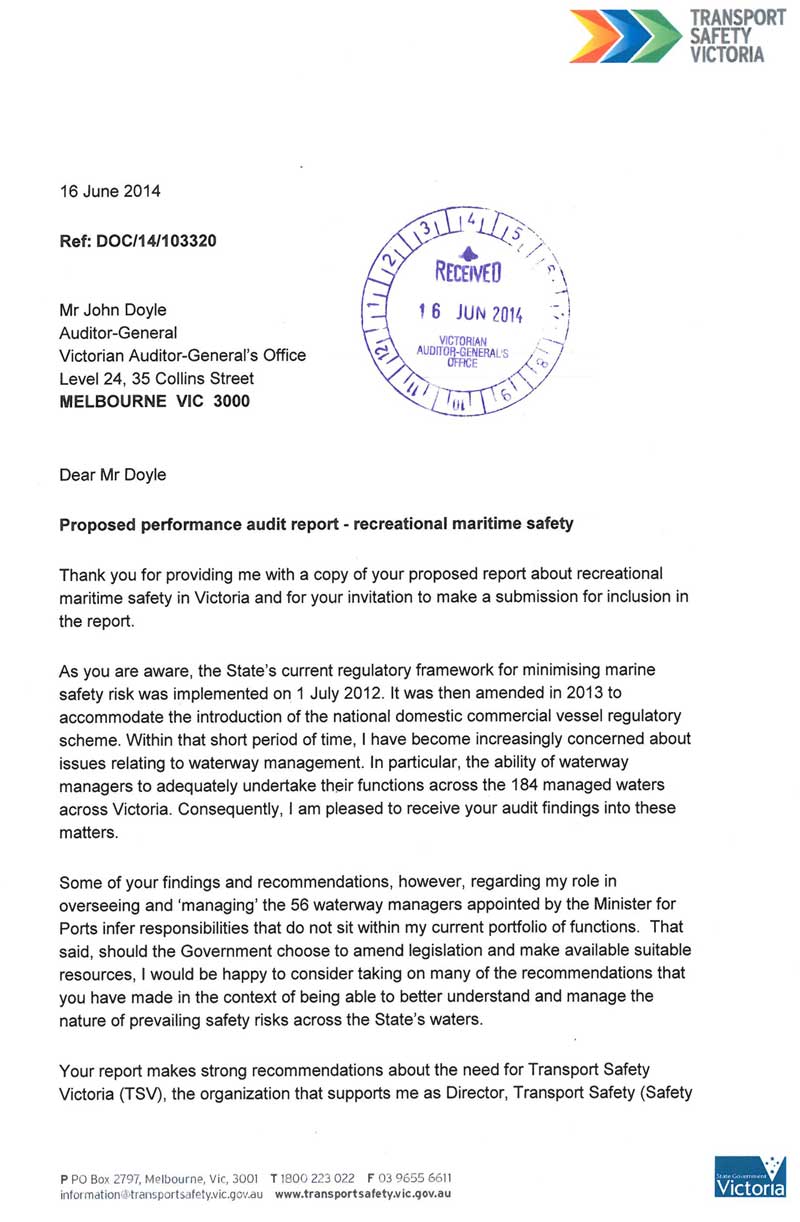
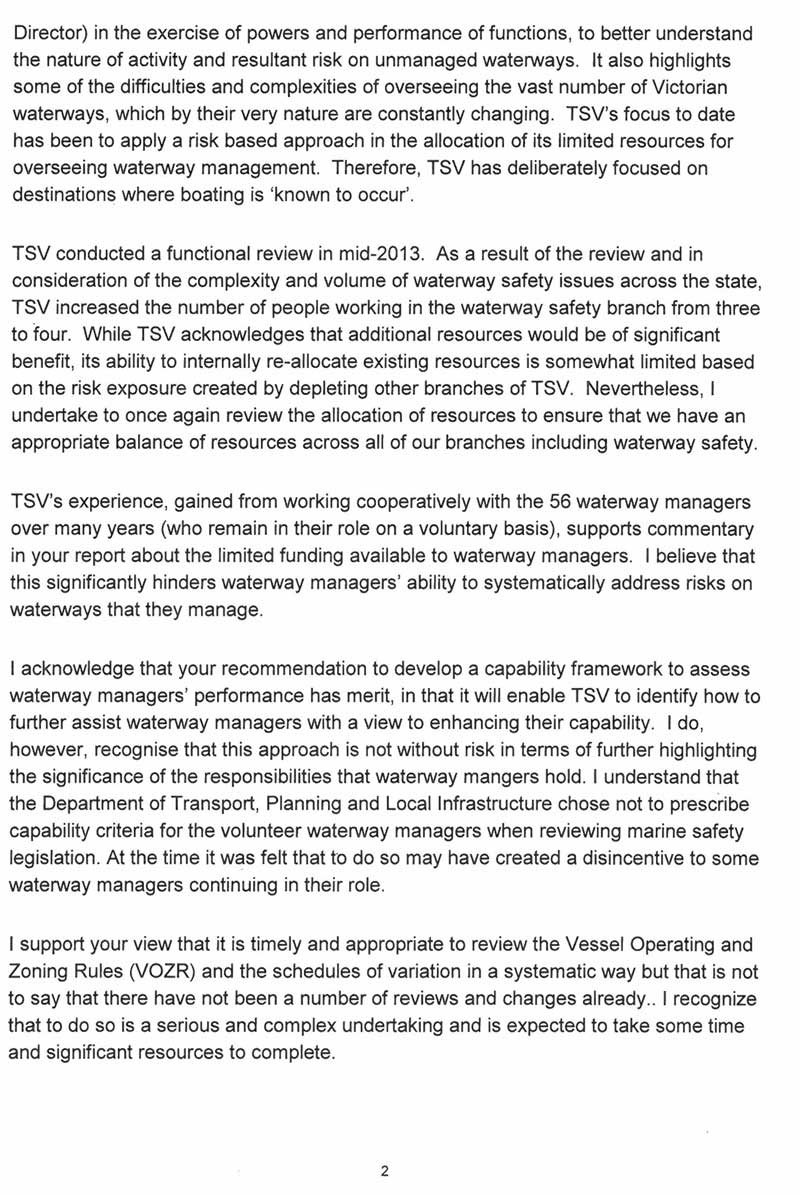
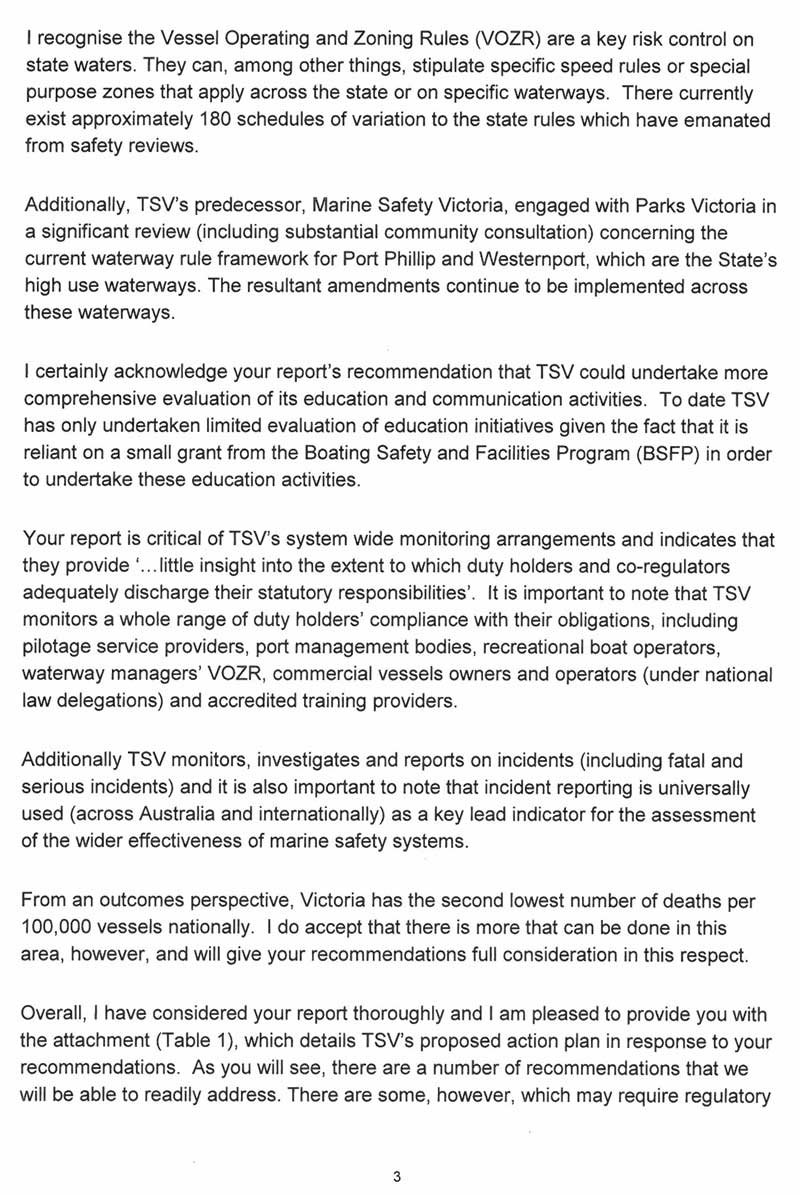
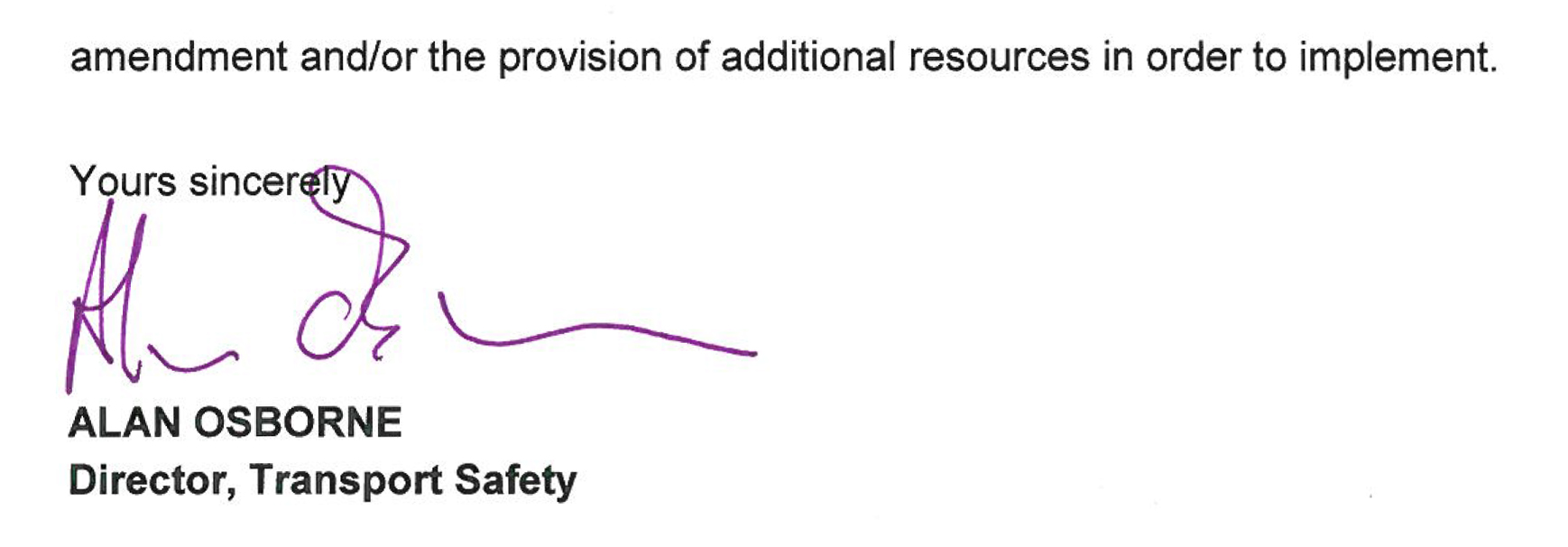
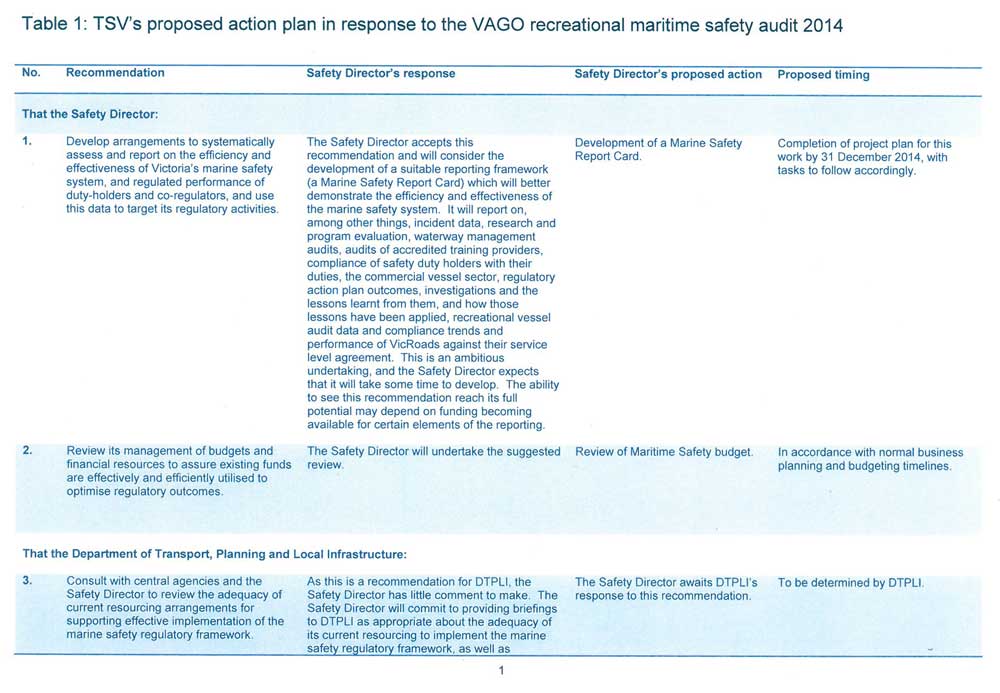
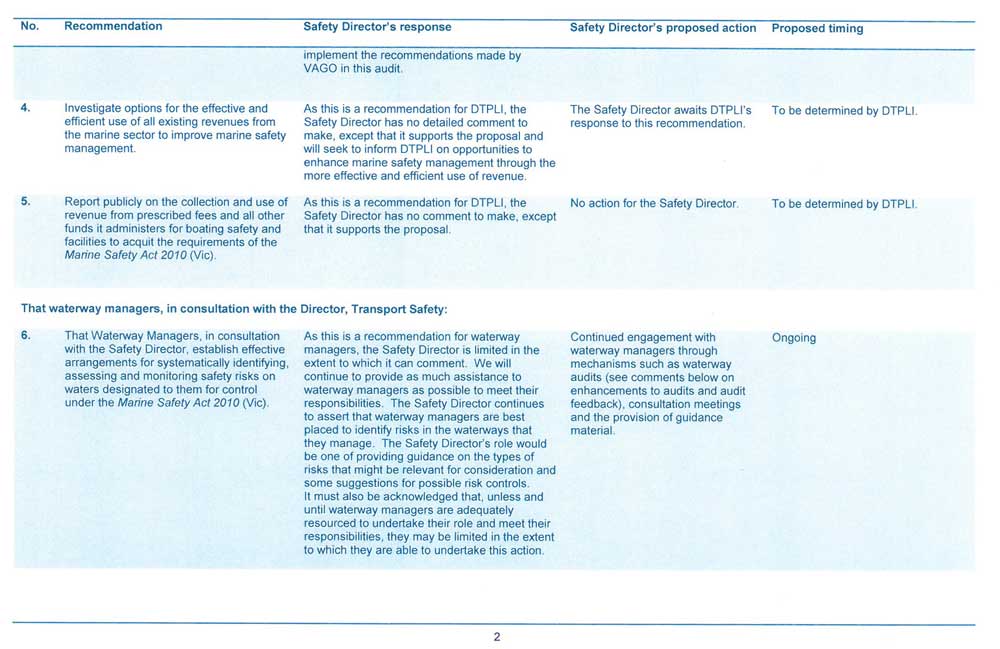
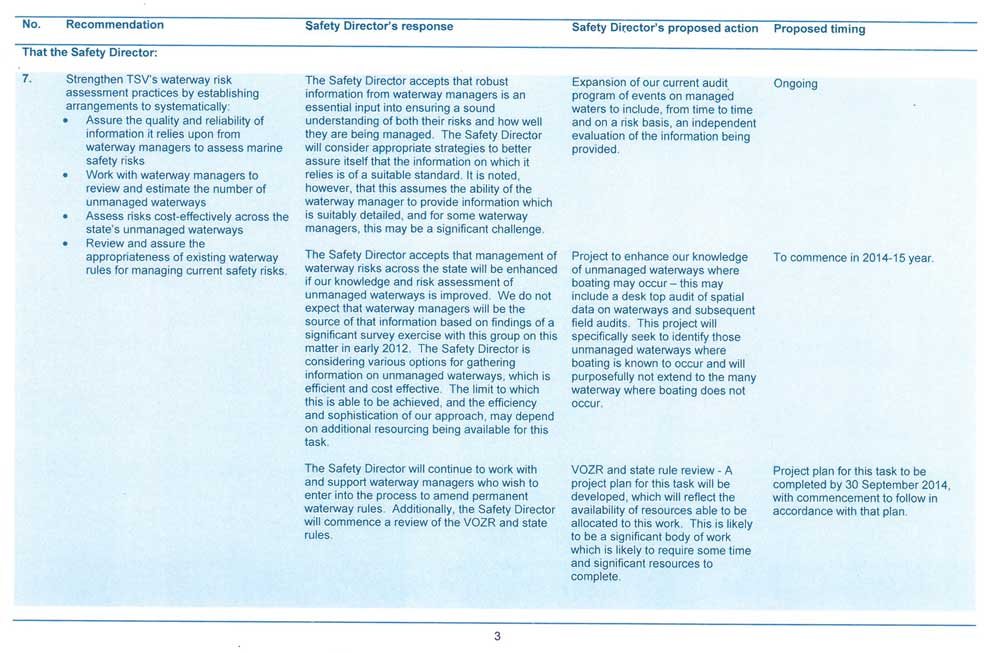
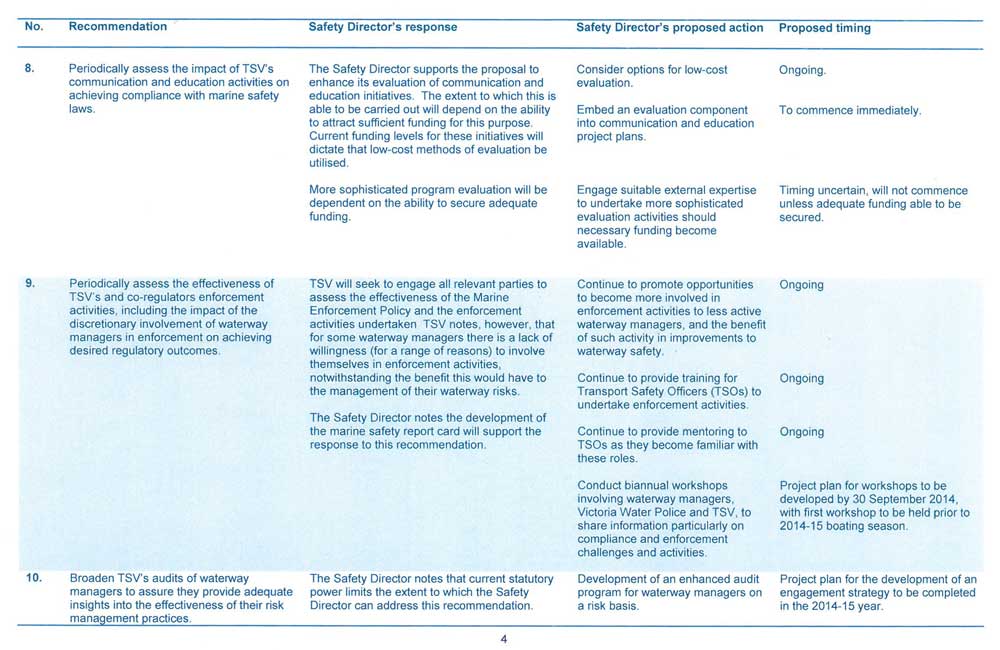
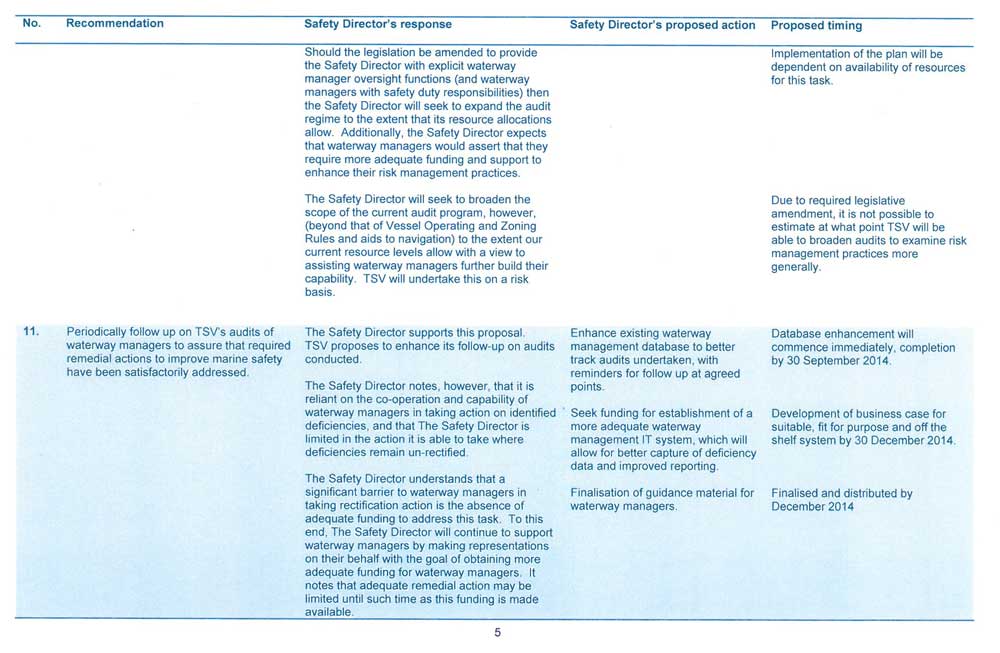
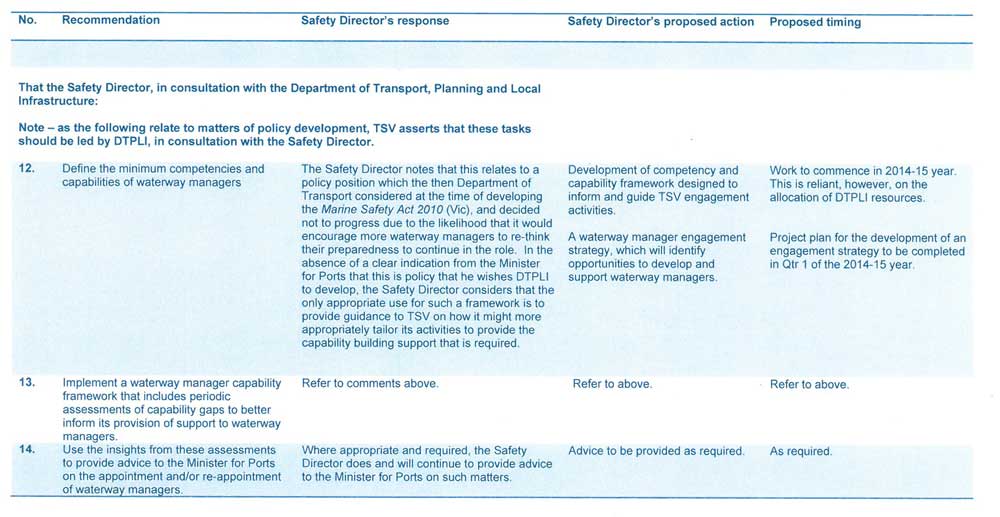
RESPONSE provided by the Secretary, Department of Transport, Planning and Local Infrastructure
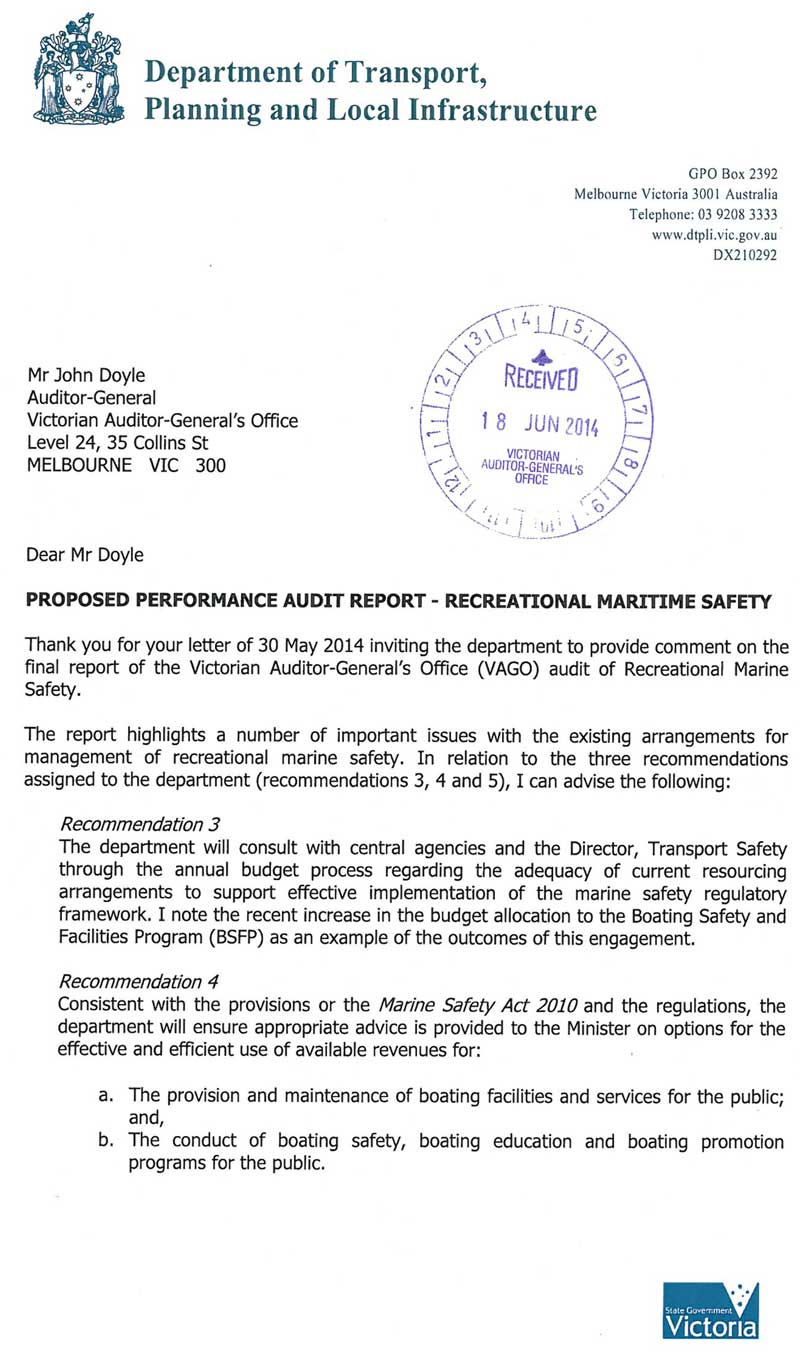
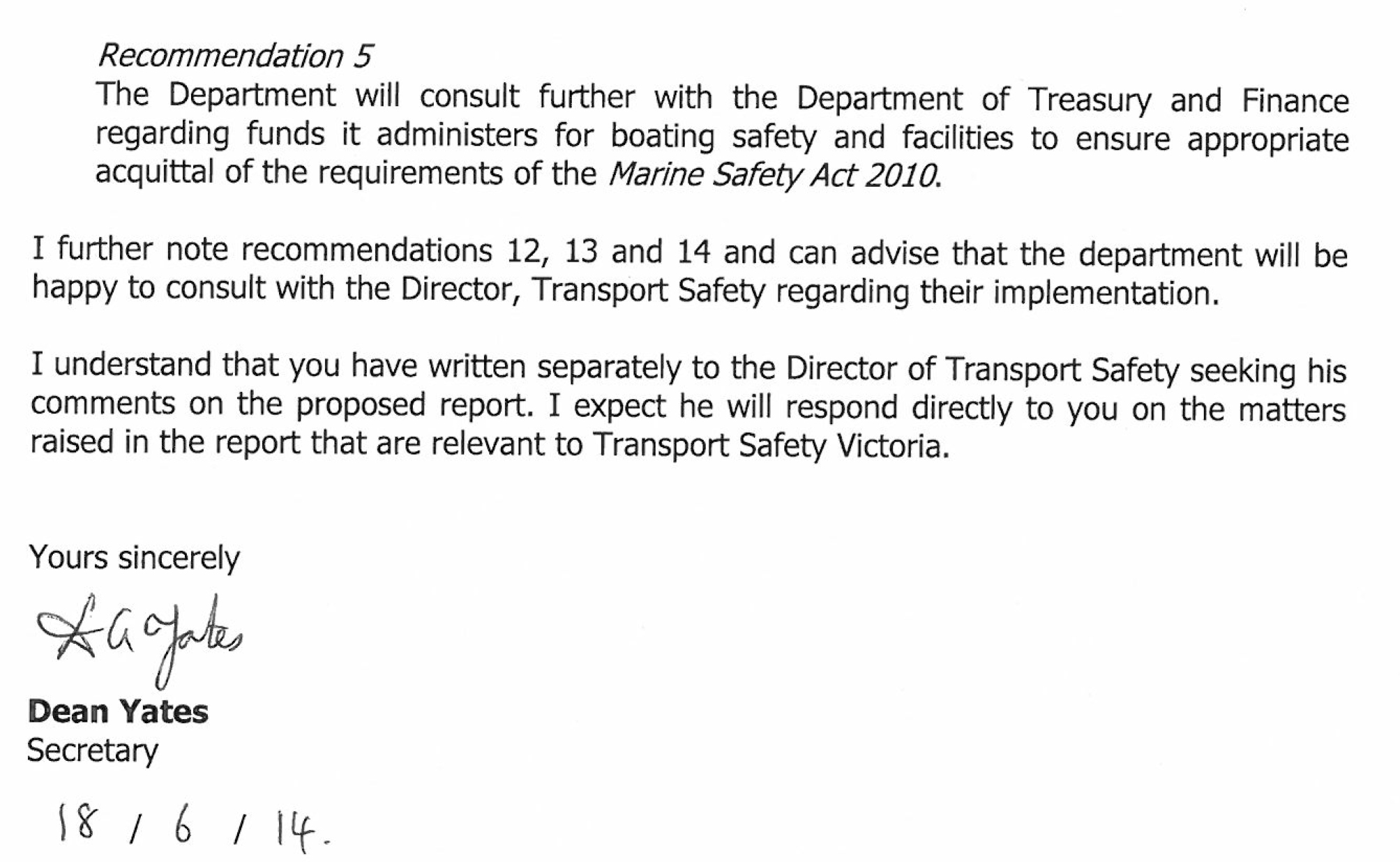
RESPONSE provided by the Secretary, Department of Environment and Primary Industries.
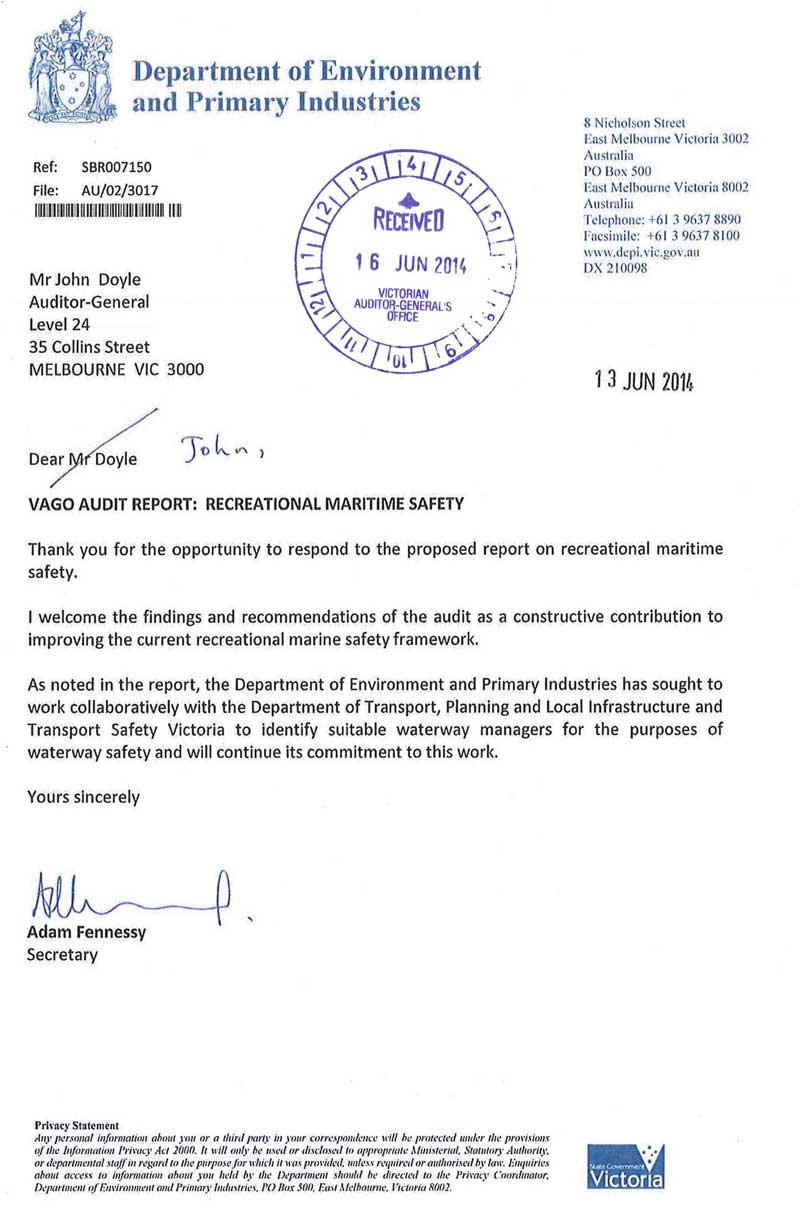
RESPONSE provided by the Chief Executive, Parks Victoria.
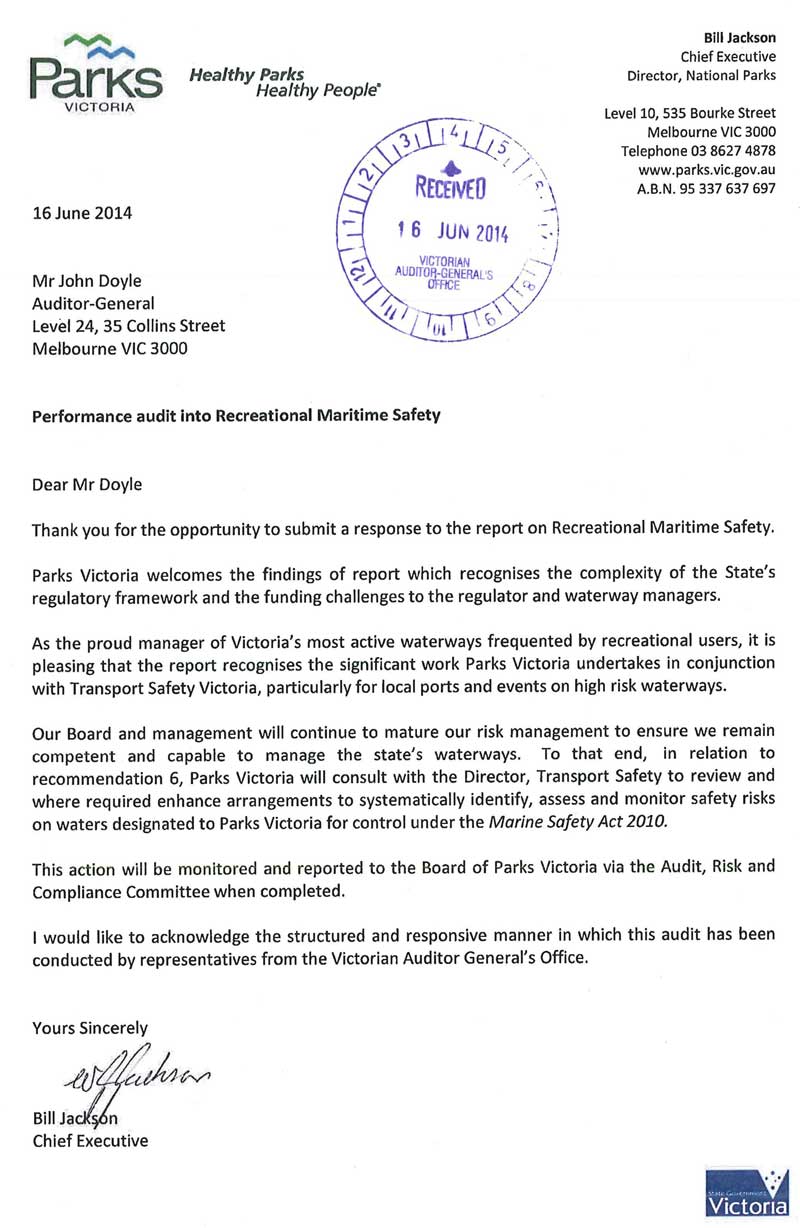
RESPONSE provided by the Chief Executive Officer, Gippsland Ports.
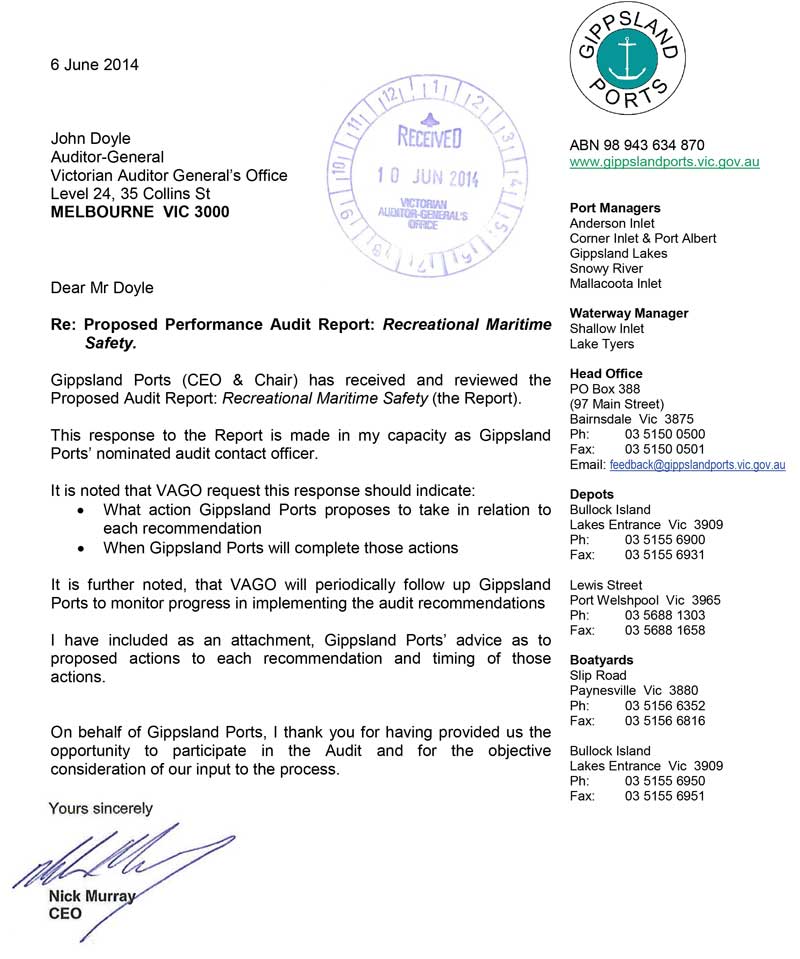
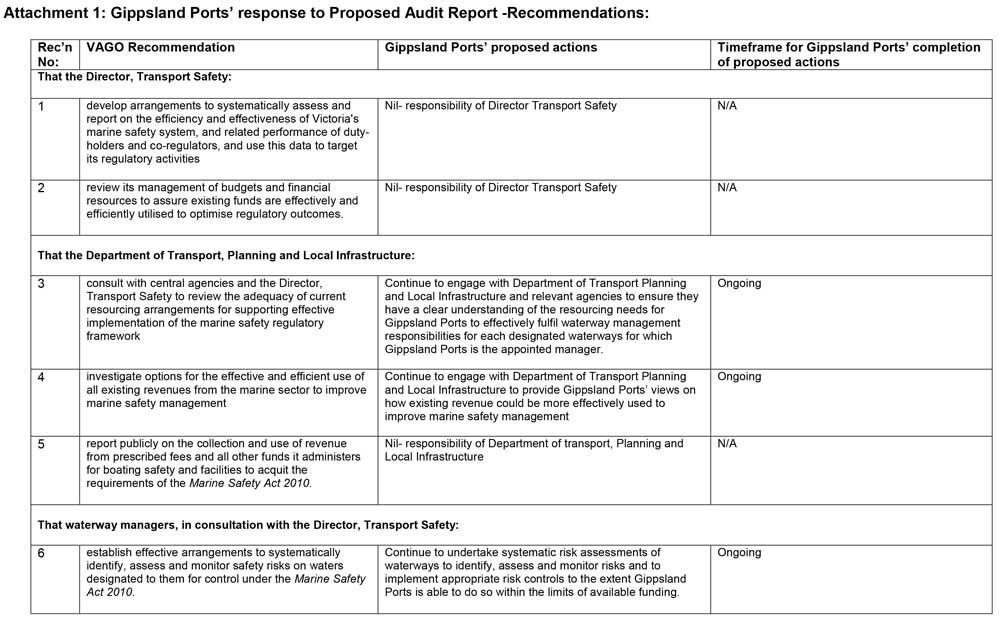
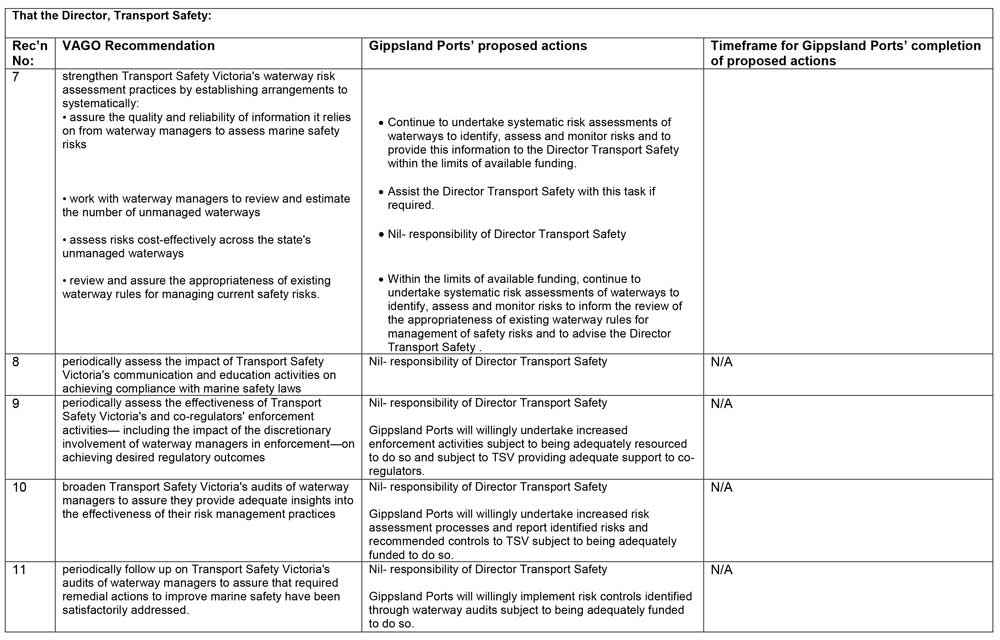
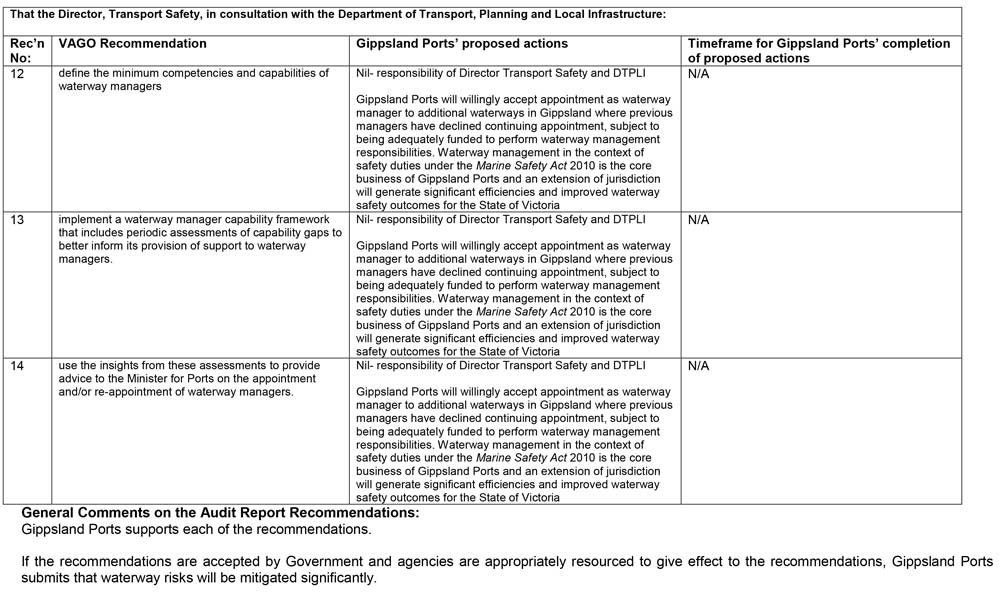

RESPONSE provided by the Managing Director, Goulburn‑Murray Rural Water Corporation
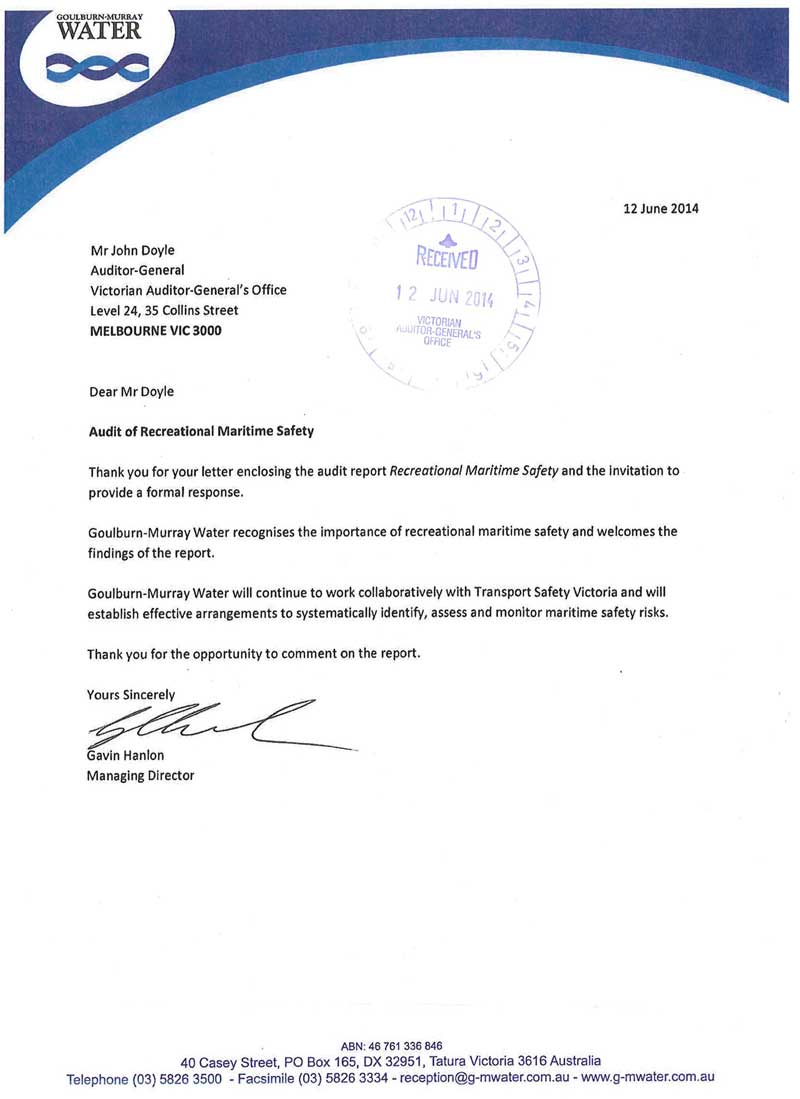
RESPONSE provided by the Chief Executive Officer, Gannawarra Shire Council.
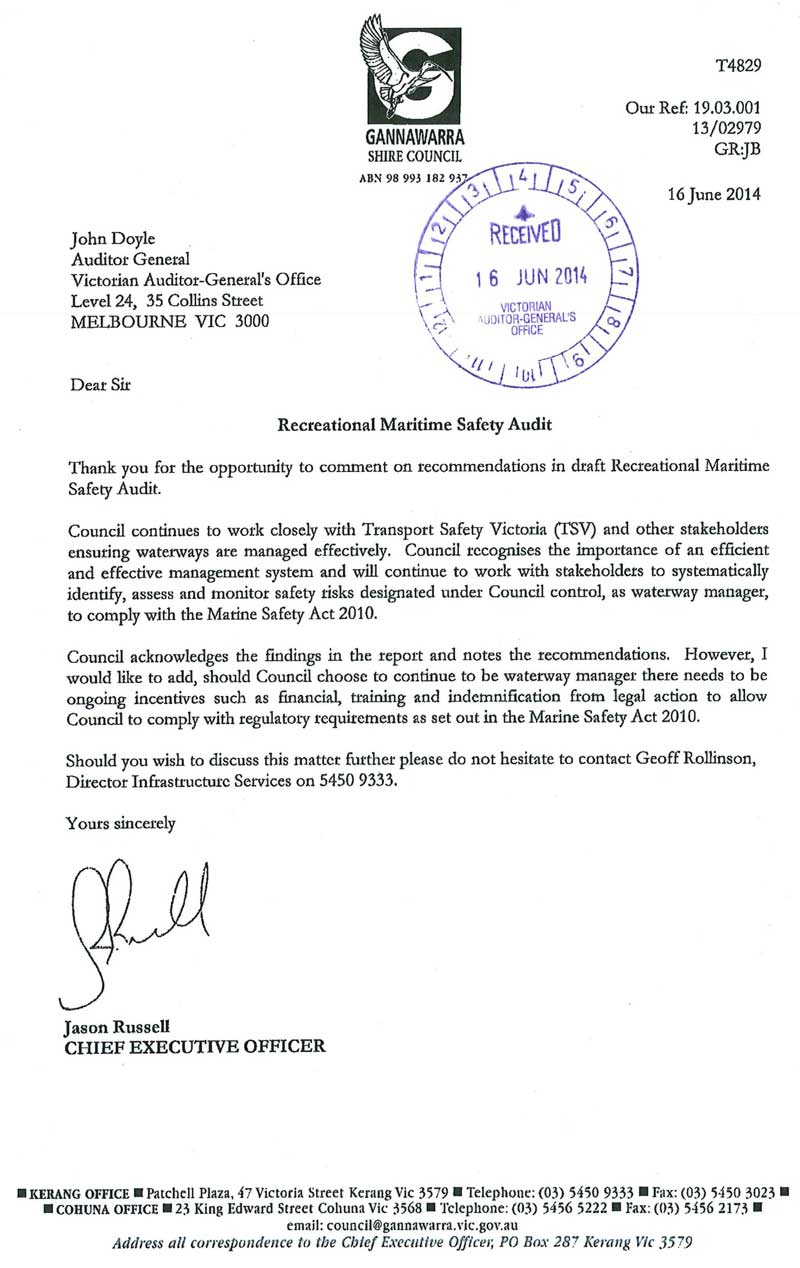
RESPONSE provided by the Chief Commissioner, Victoria Police.
